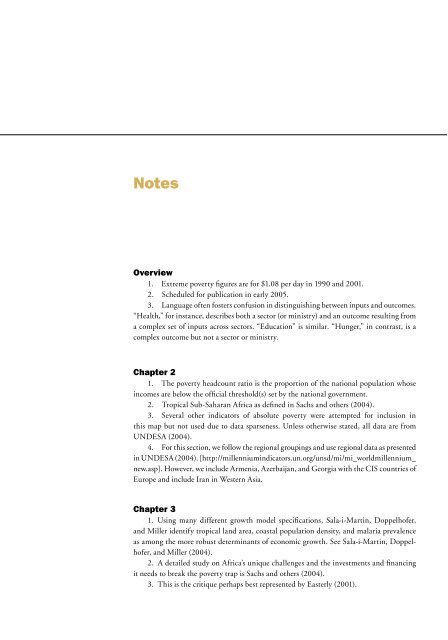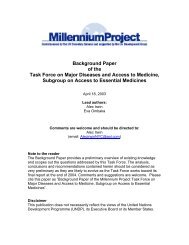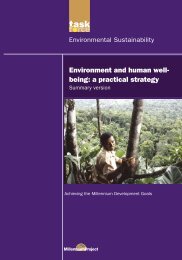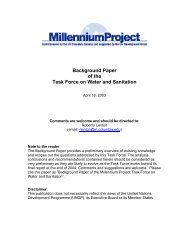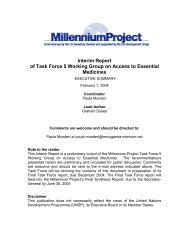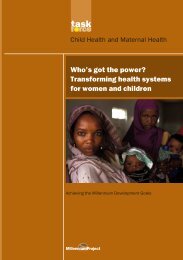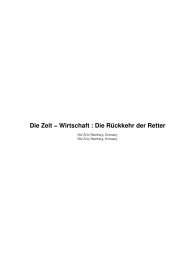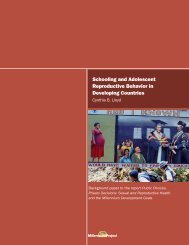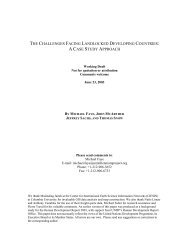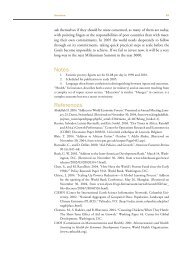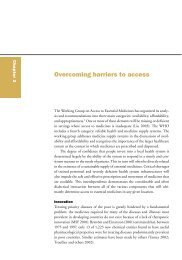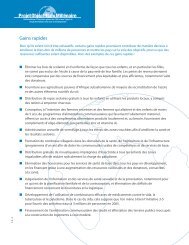Investing in Development A Practical Plan to Achieve the Millennium ...
Investing in Development A Practical Plan to Achieve the Millennium ...
Investing in Development A Practical Plan to Achieve the Millennium ...
Create successful ePaper yourself
Turn your PDF publications into a flip-book with our unique Google optimized e-Paper software.
Notes<br />
Overview<br />
1. Extreme poverty figures are for $1.08 per day <strong>in</strong> 1990 and 2001.<br />
2. Scheduled for publication <strong>in</strong> early 2005.<br />
3. Language often fosters confusion <strong>in</strong> dist<strong>in</strong>guish<strong>in</strong>g between <strong>in</strong>puts and outcomes.<br />
“Health,” for <strong>in</strong>stance, describes both a sec<strong>to</strong>r (or m<strong>in</strong>istry) and an outcome result<strong>in</strong>g from<br />
a complex set of <strong>in</strong>puts across sec<strong>to</strong>rs. “Education” is similar. “Hunger,” <strong>in</strong> contrast, is a<br />
complex outcome but not a sec<strong>to</strong>r or m<strong>in</strong>istry.<br />
Chapter 2<br />
1. The poverty headcount ratio is <strong>the</strong> proportion of <strong>the</strong> national population whose<br />
<strong>in</strong>comes are below <strong>the</strong> official threshold(s) set by <strong>the</strong> national government.<br />
2. Tropical Sub-Saharan Africa as def<strong>in</strong>ed <strong>in</strong> Sachs and o<strong>the</strong>rs (2004).<br />
3. Several o<strong>the</strong>r <strong>in</strong>dica<strong>to</strong>rs of absolute poverty were attempted for <strong>in</strong>clusion <strong>in</strong><br />
this map but not used due <strong>to</strong> data sparseness. Unless o<strong>the</strong>rwise stated, all data are from<br />
UNDESA (2004).<br />
4. For this section, we follow <strong>the</strong> regional group<strong>in</strong>gs and use regional data as presented<br />
<strong>in</strong> UNDESA (2004). [http://millennium<strong>in</strong>dica<strong>to</strong>rs.un.org/unsd/mi/mi_worldmillennium_<br />
new.asp]. However, we <strong>in</strong>clude Armenia, Azerbaijan, and Georgia with <strong>the</strong> CIS countries of<br />
Europe and <strong>in</strong>clude Iran <strong>in</strong> Western Asia.<br />
Chapter 3<br />
1. Us<strong>in</strong>g many different growth model specifications, Sala-i-Mart<strong>in</strong>, Doppelhofer,<br />
and Miller identify tropical land area, coastal population density, and malaria prevalence<br />
as among <strong>the</strong> more robust determ<strong>in</strong>ants of economic growth. See Sala-i-Mart<strong>in</strong>, Doppelhofer,<br />
and Miller (2004).<br />
2. A detailed study on Africa’s unique challenges and <strong>the</strong> <strong>in</strong>vestments and f<strong>in</strong>anc<strong>in</strong>g<br />
it needs <strong>to</strong> break <strong>the</strong> poverty trap is Sachs and o<strong>the</strong>rs (2004).<br />
3. This is <strong>the</strong> critique perhaps best represented by Easterly (2001).
Notes<br />
305<br />
Chapter 4<br />
1. It should also <strong>in</strong>clude gender expertise, which is <strong>to</strong>o frequently dropped <strong>in</strong> realtime<br />
activities.<br />
Chapter 5<br />
1. Essential health services related <strong>to</strong> <strong>the</strong> Goals <strong>in</strong>clude preventive and curative health,<br />
reproductive health, environmental health, and nutrition.<br />
2. These <strong>in</strong>terventions cannot work <strong>in</strong> isolation: <strong>the</strong>y need <strong>to</strong> be accompanied by<br />
appropriate policy reforms. These <strong>in</strong>clude <strong>in</strong>creased allocations of <strong>the</strong> national budget <strong>to</strong><br />
agriculture, l<strong>in</strong>k<strong>in</strong>g nutrition with agriculture food security and <strong>the</strong> right <strong>to</strong> adequate food<br />
and fund<strong>in</strong>g it appropriately, empower<strong>in</strong>g women with property rights <strong>to</strong> local resources,<br />
streng<strong>the</strong>n<strong>in</strong>g agricultural research, and remov<strong>in</strong>g <strong>in</strong>ternal and regional barriers <strong>to</strong> trade <strong>in</strong><br />
agricultural <strong>in</strong>puts and products (UN <strong>Millennium</strong> Project 2005d).<br />
3. See for example, World Energy Council, UN DESA, and UNDP (2000). Energy<br />
services for <strong>the</strong> Goals are discussed <strong>in</strong> more detail <strong>in</strong> a forthcom<strong>in</strong>g UN <strong>Millennium</strong> Project<br />
background paper by Vijay Modi (2004).<br />
4. From a public health perspective, it is important <strong>to</strong> reduce recourse <strong>to</strong> abortion by<br />
promot<strong>in</strong>g family plann<strong>in</strong>g services and levels of unsafe abortion by review<strong>in</strong>g <strong>the</strong> laws<br />
regulat<strong>in</strong>g abortion <strong>to</strong> ensure that <strong>the</strong>y address risks <strong>to</strong> health as well as cultural values and<br />
diversity and <strong>in</strong>stitutional capacity.<br />
5. Social protection consists of health <strong>in</strong>surance, disability through work, unemployment<br />
<strong>in</strong>surance, child ma<strong>in</strong>tenance, social security, and old-age pensions.<br />
Chapter 6<br />
1. Tools for <strong>the</strong> job are also an important part of capacity and <strong>in</strong>clude consumables or<br />
commodities required for service delivery. These are part and parcel of <strong>the</strong> recommendations<br />
<strong>in</strong> chapter 5 and <strong>in</strong> <strong>the</strong> task force reports. Here we focus on <strong>the</strong> first three components<br />
of capacity.<br />
2. See, for example, <strong>the</strong> case studies and <strong>in</strong>ternational study of <strong>the</strong> PARIS21 Task<br />
Team on Improved Statistical Support for Moni<strong>to</strong>r<strong>in</strong>g <strong>Development</strong> Goals, available at<br />
www.paris21.org.<br />
3. De<strong>in</strong><strong>in</strong>ger and Mpuga (2004) conclude: “We f<strong>in</strong>d that <strong>the</strong> policy change [abolition<br />
of user fees] improved access and reduced <strong>the</strong> probability of sickness <strong>in</strong> a way that was<br />
particularly beneficial <strong>to</strong> <strong>the</strong> poor. Although <strong>the</strong> challenge of ma<strong>in</strong>ta<strong>in</strong><strong>in</strong>g service quality<br />
rema<strong>in</strong>s, aggregate benefits are estimated <strong>to</strong> be significantly larger than <strong>the</strong> estimated<br />
shortfalls from <strong>the</strong> abolition of user fees.”<br />
Chapter 7<br />
1. Many researchers have advanced this po<strong>in</strong>t, with important early evidence presented<br />
by Knack and Keefer (1995), Mauro (1995), and Sachs and Warner (1995).<br />
2. A number of recent studies have analyzed <strong>the</strong> relationship between governance and<br />
<strong>in</strong>come <strong>in</strong> detail. For example, Radelet (2004) constructs an adjusted governance <strong>in</strong>dica<strong>to</strong>r<br />
controll<strong>in</strong>g for levels of <strong>in</strong>come. It shows that many low-<strong>in</strong>come countries perform very<br />
well on governance relative <strong>to</strong> <strong>the</strong>ir level of <strong>in</strong>come.<br />
3. Glaeser and o<strong>the</strong>rs (2004) also make this po<strong>in</strong>t.<br />
4. See, for example, “The Right of Everyone <strong>to</strong> <strong>the</strong> Highest Atta<strong>in</strong>able Standard of<br />
Physical and Mental Health” (UN 2004d).
306 Notes<br />
5. Article 25 of <strong>the</strong> United Nations International Covenant on Civil and Political Rights<br />
states only that “Every citizen shall have <strong>the</strong> right and <strong>the</strong> opportunity, [without discrim<strong>in</strong>ation]<br />
and without unreasonable restrictions: (a) <strong>to</strong> take part <strong>in</strong> <strong>the</strong> conduct of public affairs,<br />
directly or through freely chosen representatives ….” This statement of <strong>the</strong> right <strong>to</strong> participate<br />
must be seen <strong>in</strong> <strong>the</strong> context of o<strong>the</strong>r rights recognized <strong>in</strong> <strong>the</strong> Universal Declaration, which<br />
give substance <strong>to</strong> it. They <strong>in</strong>clude <strong>the</strong> right <strong>to</strong> freedom of speech, <strong>the</strong> right <strong>to</strong> nondiscrim<strong>in</strong>ation,<br />
<strong>the</strong> rights <strong>to</strong> assembly and association, <strong>the</strong> right <strong>to</strong> a free press, and so on.<br />
6. See UN (1998) on “The role of national human rights <strong>in</strong>stitutions <strong>in</strong> <strong>the</strong> protection<br />
of economic, social and cultural rights.” (E/C.12/1998/25); and see UN (2002e) on “The<br />
role of <strong>in</strong>dependent national human rights <strong>in</strong>stitutions <strong>in</strong> <strong>the</strong> promotion and protection of<br />
<strong>the</strong> rights of <strong>the</strong> child.”<br />
7. World <strong>Development</strong> Report 2005 draws this analysis from World Bank (2004a).<br />
Chapter 8<br />
1. Civil society organizations refer <strong>to</strong> a broad group of organizations and ac<strong>to</strong>rs <strong>in</strong>clud<strong>in</strong>g<br />
but not limited <strong>to</strong> community-based organizations, nongovernmental organizations,<br />
bus<strong>in</strong>ess associations, th<strong>in</strong>k tanks, social movements, religious organizations, women’s rights<br />
movements, grassroots and <strong>in</strong>digenous people’s movements, and voluntary organizations.<br />
Chapter 9<br />
1. The government holds primary responsibility <strong>to</strong> create <strong>in</strong>centives for <strong>in</strong>formal<br />
entrepreneurs <strong>to</strong> enter <strong>the</strong> formal economy—by enabl<strong>in</strong>g access <strong>to</strong> credit, better technologies,<br />
and o<strong>the</strong>r <strong>in</strong>puts, by simplify<strong>in</strong>g registration systems, and by provid<strong>in</strong>g access <strong>to</strong><br />
tra<strong>in</strong><strong>in</strong>g, as described <strong>in</strong> chapter 7.<br />
Chapter 10<br />
1. This chapter draws extensively from “End<strong>in</strong>g Africa’s Poverty Trap,” Sachs and<br />
o<strong>the</strong>rs (2004).<br />
2. A regression (not reported here) of several different governance <strong>in</strong>dica<strong>to</strong>rs on log<br />
GDP per capita PPP and a dummy for tropical Sub-Saharan Africa results <strong>in</strong> a statistically<br />
<strong>in</strong>significant coefficient for <strong>the</strong> dummy variable, <strong>in</strong>dicat<strong>in</strong>g that Africa is not governed<br />
worse, after controll<strong>in</strong>g for <strong>in</strong>come.<br />
3. O<strong>the</strong>r evidence suggests, for example, that between 1986 and 1988 long-distance<br />
freight tariffs <strong>in</strong> francophone West Africa were more than five times higher than comparable<br />
tariffs <strong>in</strong> India, Pakistan, and Viet Nam (Rizet and H<strong>in</strong>e 1993). A more recent<br />
study suggests that long-distance freight rates <strong>in</strong> Tanzania are three times higher than <strong>in</strong><br />
Indonesia (H<strong>in</strong>e and Ellis 2001).<br />
Chapter 11<br />
1. UN Department of Economic and Social Affairs, Statistics Division 2004; based<br />
on data provided by <strong>the</strong> United Nations Children’s Fund, World Health Organization,<br />
and Food and Agriculture Organization of <strong>the</strong> United Nations. The numbers represent<br />
unweighted averages for Least Developed Countries <strong>in</strong> <strong>the</strong> regions.<br />
2. The 14 priority areas <strong>in</strong>cluded: climate change and sea-level rise; natural and<br />
environmental disasters; management of wastes; coastal and mar<strong>in</strong>e resources; freshwater<br />
resources; land, energy, <strong>to</strong>urism, and biodiversity resources; national <strong>in</strong>stitutions and
Notes<br />
307<br />
adm<strong>in</strong>istrative capacity; regional <strong>in</strong>stitutions and technical cooperation; transport and<br />
communication; science and technology; and human resource development (UN 1994).<br />
3. The <strong>in</strong>dex for each hazard is created based on population distribution, severity of<br />
each hazard, and hazard mortality rate data for a 20-year period from 1981 <strong>to</strong> 2000. See<br />
Dilley and o<strong>the</strong>rs (2005) for fur<strong>the</strong>r explanation. The <strong>in</strong>dex is based on authors’ calculations,<br />
by multiply<strong>in</strong>g <strong>the</strong> country’s percentage of population exposed <strong>to</strong> different severities<br />
of each hazard <strong>to</strong> create a 0–10 <strong>in</strong>dex where a higher number <strong>in</strong>dicates more severe hazard<br />
exposure or a larger percentage of <strong>the</strong> population exposed.<br />
Chapter 12<br />
1. Based on Fearon and Lait<strong>in</strong> (2003) dataset. Note that 3 percent was <strong>the</strong> average<br />
annual risk of a new conflict experience by Sub-Saharan African countries <strong>in</strong> <strong>the</strong> 1990s.<br />
2. When <strong>the</strong> basic issues <strong>in</strong> a particular conflict are threats <strong>to</strong> identity, cultural or religious,<br />
not <strong>the</strong> economic disadvantage of some regions or groups, more political measures<br />
may have <strong>to</strong> be undertaken.<br />
3. By structural <strong>in</strong>dica<strong>to</strong>rs we refer <strong>to</strong> economic, social, environmental and geographic<br />
descrip<strong>to</strong>rs of groups and communities; by behavioral <strong>in</strong>dica<strong>to</strong>rs we refer <strong>to</strong> <strong>in</strong>dividual and<br />
group decisionmak<strong>in</strong>g <strong>in</strong>dica<strong>to</strong>rs, <strong>in</strong>clud<strong>in</strong>g protests, strikes, and riots.<br />
4. For fur<strong>the</strong>r evidence on <strong>the</strong> l<strong>in</strong>ger<strong>in</strong>g public health effects of civil wars, see Ghobarah,<br />
Huth, and Russett (2004).<br />
5. Related proposals have already been voiced <strong>in</strong> o<strong>the</strong>r contexts. See, for example,<br />
International Peace Academy (2004).<br />
Chapter 13<br />
1. For example, Harrison, Klugman, and Swanson (2003) show <strong>the</strong> lack of PRSP<br />
alignment with <strong>the</strong> <strong>Millennium</strong> <strong>Development</strong> Goals. Their table 5, for example, <strong>in</strong>dicates<br />
that 7 of 12 recent PRSPs do not even <strong>in</strong>clude targets that can be compared with <strong>the</strong> hunger<br />
Goal. Similarly, 7 of 12 do not have targets relevant <strong>to</strong> <strong>the</strong> education Goal.<br />
Chapter 15<br />
1. For example, <strong>in</strong> 1999 only 1 percent of exports from Least Developed Countries<br />
went <strong>to</strong> o<strong>the</strong>r LDCs, with o<strong>the</strong>r develop<strong>in</strong>g countries account<strong>in</strong>g for ano<strong>the</strong>r 28 percent<br />
(UNCTAD 2001).<br />
2. For example, <strong>the</strong> Inter-American <strong>Development</strong> Bank allocates a mere $10 million<br />
of a $6 billion portfolio <strong>to</strong> grants-based fund<strong>in</strong>g for regional <strong>in</strong>frastructure (Birdsall<br />
2004).<br />
3. The Johannesburg <strong>Plan</strong> of Implementation states: “All countries should promote<br />
susta<strong>in</strong>able consumption and production patterns, with <strong>the</strong> developed countries tak<strong>in</strong>g <strong>the</strong><br />
lead” (paragraph 14).<br />
Chapter 17<br />
1. Subtract<strong>in</strong>g $21 billion from <strong>the</strong> MDG f<strong>in</strong>anc<strong>in</strong>g gap of $73 billion <strong>in</strong> 2005 yields<br />
$52 billion. Similarly, subtract<strong>in</strong>g $25 billion from $135 billion yields $110 billion.<br />
2. Analysis for this chapter was conducted us<strong>in</strong>g 2002 data. Aggregate ODA figures<br />
for 2003 were released just prior <strong>to</strong> publication of this report and are thus <strong>in</strong>cluded <strong>in</strong> <strong>the</strong><br />
discussion here.
308 Notes<br />
3. The Handbook for Best Practice <strong>to</strong> Meet <strong>the</strong> MDGs, scheduled for publication <strong>in</strong><br />
early 2005, describes <strong>the</strong> needs assessments <strong>in</strong> more detail.<br />
4. The difficulty of estimat<strong>in</strong>g <strong>the</strong> potential for <strong>in</strong>creas<strong>in</strong>g resource mobilization by<br />
<strong>the</strong> government is reflected <strong>in</strong> conflict<strong>in</strong>g comments received on earlier drafts of <strong>the</strong> UN<br />
<strong>Millennium</strong> Project’s needs assessment results. The World Bank judged an <strong>in</strong>crease of four<br />
percentage po<strong>in</strong>ts <strong>in</strong> Uganda as <strong>to</strong>o low, while <strong>the</strong> IMF thought <strong>the</strong> same estimate was <strong>to</strong>o<br />
high (World Bank 2003e; IMF 2003).<br />
5. This assumes that 25 percent of all MDG-related <strong>in</strong>vestments will go <strong>to</strong>ward tradables,<br />
as suggested by <strong>the</strong> UN <strong>Millennium</strong> Project needs assessments.<br />
6. All data on 2002 ODA flows are based on OECD/DAC (2004a). Additional <strong>in</strong>formation<br />
has been provided by <strong>the</strong> OECD/DAC secretariat. We are particularly grateful <strong>to</strong><br />
Brian Hammond for his <strong>in</strong>valuable support. Additional details on <strong>the</strong> analysis are provided<br />
<strong>in</strong> appendix 3.<br />
7. Unfortunately, no robust cost estimates are available for implement<strong>in</strong>g <strong>the</strong> o<strong>the</strong>r<br />
two Rio conventions. Table 17.3 thus does not <strong>in</strong>clude <strong>the</strong> cost of protect<strong>in</strong>g biodiversity<br />
and implement<strong>in</strong>g <strong>the</strong> UN Framework Convention on Climate Change.<br />
8. The OECD/DAC uses a projection of 2 percent a year real growth <strong>in</strong> members’<br />
GNI—from $30 trillion <strong>in</strong> 2005 <strong>to</strong> $36 trillion <strong>in</strong> 2015.<br />
Chapter 18<br />
1. The estimation methodology and data sources used are summarized <strong>in</strong> appendix 4.<br />
Appendix 1<br />
1. These primary and postprimary education categories focus on priorities highlighted<br />
by <strong>the</strong> UN <strong>Millennium</strong> Project Task Force on Education, although <strong>the</strong>y are not an<br />
exhaustive list of all task force <strong>in</strong>terventions.<br />
Appendix 3<br />
1. The follow<strong>in</strong>g assumptions were made based on public expenditure data: Pakistan<br />
and Viet Nam 8–12 percent, Indonesia 9–13 percent, Ch<strong>in</strong>a and India 14–16 percent.<br />
2. Under <strong>the</strong> terms of <strong>the</strong> OECD/DAC, concessional loans do not qualify for debt<br />
relief that counts <strong>to</strong>ward ODA.<br />
3. For comparison, <strong>in</strong> 2003 only 53 percent of appeals for emergency aid made<br />
through <strong>the</strong> UN’s Consolidated Appeals Process <strong>in</strong> 2003 were funded (exclud<strong>in</strong>g Iraq),<br />
even if one assumes that some fund<strong>in</strong>g requests may be <strong>to</strong>o high.<br />
Appendix 4<br />
1. Available onl<strong>in</strong>e at http://www.oecd.org/dataoecd/43/43/1894330.xls.
References<br />
Abdullah II. 2004. “Address <strong>to</strong> World Economic Forum.” Presented at Annual Meet<strong>in</strong>g,<br />
January 23, Davos, Switzerland. [Retrieved on November 30, 2004, from www.<br />
k<strong>in</strong>gabdullah.jo/press_room/speechpage.php?ki_serial=231&menu_id=607&lang_<br />
hmka1=1].<br />
African Agricultural Market Information Network. 2004. “Regional Inputs.” [Retrieved<br />
on March 8, 2004, from www.afam<strong>in</strong>.net/regionalenglish/reg_mis_en.asp].<br />
Als<strong>to</strong>n, P. 2004. “A Human Rights Perspective on <strong>the</strong> <strong>Millennium</strong> <strong>Development</strong> Goals.”<br />
Background paper for <strong>the</strong> UN <strong>Millennium</strong> Project Task Force on Poverty and Economic<br />
<strong>Development</strong>. UN <strong>Millennium</strong> Project, New York.<br />
Andreassi, T. 2003. “Innovation <strong>in</strong> Small and Medium Enterprises.” International Journal<br />
of Entrepreneurship and Innovation Management 3 (1/2): 99–106.<br />
Annan, K. 2004. “Africa’s Green Revolution—A Call <strong>to</strong> Action.” Address <strong>to</strong> <strong>the</strong> Highlevel<br />
Sem<strong>in</strong>ar on Innovative Approaches <strong>to</strong> Meet <strong>the</strong> Hunger <strong>Millennium</strong> <strong>Development</strong><br />
Goal <strong>in</strong> Africa, July 5, Addis Ababa. [Retrieved on December 7, 2004, from<br />
www.un.org/News/Press/docs/2004/sgsm9405.doc.htm].<br />
Asian <strong>Development</strong> Bank. 2003. “<strong>Millennium</strong> <strong>Development</strong> Goals <strong>in</strong> <strong>the</strong> Pacific: Relevance<br />
and Progress.” Manila.<br />
Atk<strong>in</strong>son, A. B. 2004. “New Sources of <strong>Development</strong> F<strong>in</strong>ance: Fund<strong>in</strong>g <strong>the</strong> <strong>Millennium</strong><br />
<strong>Development</strong> Goals.” WIDER Policy Brief 10. United Nations University, World<br />
Institute for <strong>Development</strong> Economics Research, Hels<strong>in</strong>ki. [www.wider.unu.edu/publications/policy-brief/PB10.pdf].<br />
Bajpai, N., J. D. Sachs, and N. Volavka. 2004. “Reach<strong>in</strong>g <strong>the</strong> <strong>Millennium</strong> <strong>Development</strong><br />
Goals <strong>in</strong> South Asia.” Background paper for <strong>the</strong> UN <strong>Millennium</strong> Project Task Force<br />
on Poverty and Economic <strong>Development</strong>. UN <strong>Millennium</strong> Project, New York.<br />
Balmford, A., A. Bruner, P. Cooper, R. Costanza, S. Farber, R. E. Green, M. Jenk<strong>in</strong>s, P.<br />
Jefferiss, V. Jessamy, J. Madden, K. Munro, N. Myers, S. Naeem, J. Paavola, M. Rayment,<br />
S. Rosendo, J. Roughgarden, K. Trumper, and R. K. Turner. 2002. “Ecology—<br />
Economic Reasons for Conserv<strong>in</strong>g Wild Nature.” Science 297:950–53.<br />
Barnes, D. F., K. Openshaw, K. Smith, and R. van der Plas. 1994. What Makes People<br />
Cook with Improved Biomass S<strong>to</strong>ves? World Bank Technical Paper 242. Energy Series.<br />
Wash<strong>in</strong>g<strong>to</strong>n, D.C.
310 References<br />
Barrios Salvador, L. Bert<strong>in</strong>elli, and E. Strobl. 2003. “Dry Times <strong>in</strong> Africa: Ra<strong>in</strong>fall and<br />
Africa’s Growth Performance.” Center for Operations Research and Econometrics<br />
(CORE) Discussion Paper 2003/61. Université catholique de Louva<strong>in</strong>, Belgium.<br />
Barro, R. J. 1999. “Determ<strong>in</strong>ants of Democracy.” Journal of Political Economy 107 (0):<br />
S158–83.<br />
Barro, R. J., and J. W. Lee. 2000. “International Data on Educational Atta<strong>in</strong>ment: Updates<br />
and Implications.” CID Work<strong>in</strong>g Paper 42. Center for International <strong>Development</strong>.<br />
[www.cid.harvard.edu/ciddata/ciddata.html].<br />
Bernste<strong>in</strong>, S. 2004. “A Proposal for Includ<strong>in</strong>g a Measure of Unmet Need for Contraception<br />
and Adolescent Fertility or Early Marriage Levels as Indica<strong>to</strong>rs of <strong>the</strong> Reproductive<br />
Health Component of Gender Equality.” UN <strong>Millennium</strong> Project, New York.<br />
[http://unstats.un.org/unsd/mi/techgroup/subgroups/IAEG submission on unmet need<br />
v3.pdf].<br />
Bhalla, S. 2002. Imag<strong>in</strong>e There’s No Country: Poverty, Inequality, and Growth <strong>in</strong> <strong>the</strong> Era of<br />
Globalization. Wash<strong>in</strong>g<strong>to</strong>n, D.C.: Institute for International Economics.<br />
Bill and Mel<strong>in</strong>da Gates Foundation. 2003. Annual Report 2003. Seattle, Wash<strong>in</strong>g<strong>to</strong>n.<br />
Birdsall, N. 2004. “Underfunded Regionalism <strong>in</strong> <strong>the</strong> Develop<strong>in</strong>g World.” CGD Work<strong>in</strong>g<br />
Paper 49. Center for Global <strong>Development</strong>, Wash<strong>in</strong>g<strong>to</strong>n, D.C.<br />
Blair, T. 2004. “Address <strong>to</strong> African Union.” Oc<strong>to</strong>ber 7, Addis Ababa. [Retrieved on<br />
November 30, 2004, from www.pm.gov.uk/output/Page6452.asp].<br />
Bogg, L., D. Hengj<strong>in</strong>, W. Keli, C. Wenwei, and V. Diwan. 1996. The Cost of Coverage:<br />
Rural Health Insurance <strong>in</strong> Ch<strong>in</strong>a.” Health Policy and <strong>Plan</strong>n<strong>in</strong>g 11: 238–52.<br />
Bru<strong>to</strong>n, G., D. Ahlstrom, and K. Yeh. 2003. “Understand<strong>in</strong>g Venture Capital <strong>in</strong> East Asia:<br />
The Impact of Institutions on <strong>the</strong> Industry Today and Tomorrow.” Journal of World<br />
Bus<strong>in</strong>ess 39 (1): 72–88.<br />
Burnside, C., and D. Dollar. 2000. “Aid, Policies, and Growth.” American Economic Review<br />
90 (4): 847–68.<br />
Bush, G. W. 2002. “Address <strong>to</strong> <strong>the</strong> Inter-American <strong>Development</strong> Bank.” March 14, Wash<strong>in</strong>g<strong>to</strong>n,<br />
D.C. [Retrieved on November 30, 2004, from www.whitehouse.gov/news/<br />
releases/2002/03/20020314-7.html].<br />
Caixa Economica Federal, Institu<strong>to</strong> Polis, UN-HABITAT Office for Lat<strong>in</strong> America and<br />
<strong>the</strong> Caribbean. 2002. “The Statute of <strong>the</strong> City: New Tools for Assur<strong>in</strong>g <strong>the</strong> Right<br />
<strong>to</strong> <strong>the</strong> City <strong>in</strong> Brasil.” [www.polis.org.br/publicacoes/download/arquivos/statute_of_<br />
<strong>the</strong>_city.pdf]<br />
Carter, S., and B. Currie-Alder. n.d. “Scal<strong>in</strong>g Up Natural Resource Management: Insights<br />
from Research <strong>in</strong> Lat<strong>in</strong> America.” International <strong>Development</strong> Research Center,<br />
Ottawa.<br />
Casterl<strong>in</strong>e, J., and S. W. S<strong>in</strong>d<strong>in</strong>g. 2000. “Unmet Need for Family <strong>Plan</strong>n<strong>in</strong>g <strong>in</strong> Develop<strong>in</strong>g<br />
Countries and Implications for Population Policy.” Population and <strong>Development</strong><br />
Review 26 (4): 691–724.<br />
Charl<strong>to</strong>n, A. 2004. “Why Is There So Little Foreign Investment <strong>in</strong> Most Develop<strong>in</strong>g<br />
Countries: Vertical FDI <strong>in</strong> a Multi-country World.” Background Paper for <strong>the</strong> UN<br />
<strong>Millennium</strong> Project. UN <strong>Millennium</strong> Project, New York.<br />
Chen, S., and M. Ravallion. 2004. “How Have <strong>the</strong> World’s Poorest Fared s<strong>in</strong>ce <strong>the</strong> Early<br />
1980s?” Policy Research Paper 3341. World Bank, Wash<strong>in</strong>g<strong>to</strong>n, D.C.<br />
Chirac, J. 2004. “Scal<strong>in</strong>g Up Poverty Reduction—A Global Learn<strong>in</strong>g Process.” Address<br />
for <strong>the</strong> open<strong>in</strong>g of <strong>the</strong> World Bank Conference, May 26, Shanghai. [Retrieved on<br />
November 30, 2004, from www.elysee.fr/cgi-b<strong>in</strong>/auracom/aurweb/search/file?aur_<br />
file=discours/2004/UK040526.html].
References<br />
311<br />
Chocce, G. R. 2003. “Necessary Conditions for Venture Capital <strong>Development</strong> <strong>in</strong> Lat<strong>in</strong><br />
America: The Chilean Case.” International Journal of Entrepreneurship and Innovation<br />
Management 3(1/2): 139–50.<br />
Christiansen, L., C. Scott, and Q. Wodon. 2002. “<strong>Development</strong> Targets and Costs.” In<br />
J. Klugman, ed., A Sourcebook for Poverty Reduction Strategies. Vol. 2. World Bank,<br />
Wash<strong>in</strong>g<strong>to</strong>n, D.C.<br />
CIESIN (Center for International Earth Science Information Network), Columbia University.<br />
2002. “National Aggregates of Geospatial Data: Population, Landscape and<br />
Climate Estimates (PLACE).” Palisades, N.Y. [http://sedac.cies<strong>in</strong>.columbia.edu/plue/<br />
nagd/place.html].<br />
———. 2004. “Gridded Population of <strong>the</strong> World (GPW).” Version 3. Palisades, N.Y.<br />
[http://sedac.cies<strong>in</strong>.columbia.edu/gpw].<br />
———. 2005a (forthcom<strong>in</strong>g). Global Subnational Infant Mortality Rates [Dataset]. Palisades,<br />
N.Y.<br />
———. 2005b (forthcom<strong>in</strong>g). Global Subnational Rates of Child Underweight Status [Dataset].<br />
Palisades, N.Y.<br />
Clapham, A. 2001. “The Question of Jurisdiction under International Crim<strong>in</strong>al Law over<br />
Legal Persons: Lessons from <strong>the</strong> Rome Conference on an International Crim<strong>in</strong>al<br />
Court.” In M. Kamm<strong>in</strong>ga and S. Zia-Ziarifi, eds., Liability of Mult<strong>in</strong>ational Corporations<br />
under International Law. Bos<strong>to</strong>n: Mart<strong>in</strong>us Nijhoff.<br />
Clemens, M., S. Radelet, and R. Bhavnani. 2004. “Count<strong>in</strong>g Chickens When They Hatch:<br />
The Short-Term Effect of Aid on Growth.” Work<strong>in</strong>g Paper 44. Center for Global<br />
<strong>Development</strong>, Wash<strong>in</strong>g<strong>to</strong>n, D.C.<br />
Collier, P., and A. Hoeffler. 2002. “Greed and Grievance <strong>in</strong> Civil Wars.” Work<strong>in</strong>g Paper<br />
2002-01. Centre for <strong>the</strong> Study of African Economies, Oxford, UK.<br />
———. 2004. “The Challenge of Reduc<strong>in</strong>g <strong>the</strong> Global Incidence of Civil War.” Copenhagen<br />
Consensus Challenge Paper. Copenhagen Consensus, Copenhagen.<br />
Commission on Human Security. 2003. Human Security Now. United Nations. New<br />
York.<br />
Cooke, R., B. Dickens, and M. Fathalla. 2003. Reproductive Health and Human Rights:<br />
Integrat<strong>in</strong>g Medic<strong>in</strong>e, Ethics, and Law (Issues <strong>in</strong> Biomedical Ethics). Toron<strong>to</strong>: Oxford<br />
University Press.<br />
Correa, S. 1999. “ICPD: Mov<strong>in</strong>g Forward <strong>in</strong> <strong>the</strong> Eye of <strong>the</strong> S<strong>to</strong>rm.” <strong>Development</strong> Alternatives<br />
with Women for a New Era, Suva.<br />
CSR (Corporate Social Responsibility) Platform. 2003. “CSR Frame of Reference.”<br />
Amsterdam.<br />
da Silva, L. I. L. 2004. “Statement at <strong>the</strong> 59 th Session of <strong>the</strong> UN General Assembly.” September<br />
21, 2004, New York. [Retrieved on November 30, 2004, from www.brazil.org.<br />
uk/page.php?cid=1887].<br />
de Ra<strong>to</strong> y Figaredo, R. 2004. “Africa Needs International Help <strong>to</strong> Turn Promises <strong>in</strong><strong>to</strong><br />
Progress.” Bus<strong>in</strong>ess Day, November 12.<br />
Dea<strong>to</strong>n, A. 2003. “Data for Moni<strong>to</strong>r<strong>in</strong>g <strong>the</strong> Poverty MDG.” Pr<strong>in</strong>ce<strong>to</strong>n University, Research<br />
Program <strong>in</strong> <strong>Development</strong> Studies, Pr<strong>in</strong>ce<strong>to</strong>n, N.J.<br />
De<strong>in</strong><strong>in</strong>ger, K., and P. Mpuga. 2004. “Economic and Welfare Effects of <strong>the</strong> Abolition of<br />
Health User Fees: Evidence from Uganda.” Policy Research Work<strong>in</strong>g Paper 3276.<br />
World Bank, Wash<strong>in</strong>g<strong>to</strong>n, D.C.<br />
DFID (Department for International <strong>Development</strong>). 2004. “Improv<strong>in</strong>g Health <strong>in</strong> Malawi:<br />
a Sec<strong>to</strong>r-Wide Approach Includ<strong>in</strong>g Essential Health Package and Emergency Human<br />
Resources Programme.” Programme Memorandum. London.
312 References<br />
Dholakia, R., A. Kumar, and S. Datta. 2004. “<strong>Millennium</strong> <strong>Development</strong> Goals Needs<br />
Assessment at State Level <strong>in</strong> India: Madhya Pradesh, Rajasthan, Uttar Pradesh.” Background<br />
paper for <strong>the</strong> UN <strong>Millennium</strong> Project Task Force on Poverty and Economic<br />
<strong>Development</strong>. UN <strong>Millennium</strong> Project, New York.<br />
DHS (Demographic and Health Surveys). 2004. “Demographic and Health Surveys<br />
(DHS) Database.” [www.measuredhs.com].<br />
Dilley M., R. Chen, U. Deichmann, A. Lerner-Lam, and M. Arnold with J. Agwe, P. Buys,<br />
O. Kjekstad, B. Lyon, and G. Yetman. 2005. “Natural Disaster Hotspots: A Global<br />
Risk Analysis.” World Bank, Wash<strong>in</strong>g<strong>to</strong>n, D.C.<br />
Doppelhofer, G., R. I. Miller, and X. Sala-i-Mart<strong>in</strong>. 2000. “Determ<strong>in</strong>ants of Long-Term<br />
Growth: A Bayesian Averag<strong>in</strong>g of Classical Estimates (BACE) Approach.” NBER<br />
Work<strong>in</strong>g Paper 7750. National Bureau of Economic Research, Cambridge, Mass.<br />
Durand-Lasserve, A., and L. Roys<strong>to</strong>n, eds. 2002. Hold<strong>in</strong>g Their Ground: Secure Land Tenure<br />
for <strong>the</strong> Urban Poor <strong>in</strong> Develop<strong>in</strong>g Countries. Earthscan: London.<br />
Easterly, W. 1999. “The Ghost of F<strong>in</strong>anc<strong>in</strong>g Gap: Test<strong>in</strong>g <strong>the</strong> Growth Model of <strong>the</strong> International<br />
F<strong>in</strong>ancial Institutions.” Journal of <strong>Development</strong> Economics 60 (2): 423–38.<br />
———. 2001. The Elusive Quest for Growth: Economists Adventures and Misadventures <strong>in</strong><br />
<strong>the</strong> Tropics. Cambridge, Mass.: MIT Press.<br />
EI (Earthwatch Institute) (Europe), IUCN (International Union for Conservation of<br />
Nature and Natural Resources), and WBCSD (World Bus<strong>in</strong>ess Council for Susta<strong>in</strong>able<br />
<strong>Development</strong>). 2002. Bus<strong>in</strong>ess and Biodiversity: The Handbook for Corporate<br />
Action. Geneva.<br />
EIA (Energy Information Adm<strong>in</strong>istration). 1999. Energy <strong>in</strong> Africa. Wash<strong>in</strong>g<strong>to</strong>n, D.C.<br />
Ellis, S., and J. L. H<strong>in</strong>e. 1989. “The Provision of Rural Transport Services.” Sub-Saharan<br />
Africa Transport Policy Program Work<strong>in</strong>g Paper 37. World Bank, Wash<strong>in</strong>g<strong>to</strong>n, D.C.<br />
Evenson, R. 2004. Department of Economics, Yale University, personal communication<br />
with <strong>the</strong> authors.<br />
Evenson, R. E., and D. G. 2003. Crop Variety Improvement and Its Effect on Productivity: The<br />
Impact of International Research. Wall<strong>in</strong>gford, UK: CABI Publish<strong>in</strong>g.<br />
FAO (Food and Agriculture Organization). 2003a. The State of Food Insecurity <strong>in</strong> <strong>the</strong><br />
World. Rome.<br />
———. 2003b. “FAO Statistical Databases.” Rome.<br />
———. 2004. The State of Food Insecurity <strong>in</strong> <strong>the</strong> World. Rome.<br />
Faye, M., J. McArthur, T. Snow, and J. Sachs. 2004. “The Challenge Fac<strong>in</strong>g Landlocked<br />
Develop<strong>in</strong>g Countries.” Journal of Human <strong>Development</strong> 5 (1): 31–68.<br />
Fearon, J. D., and D. D. Lait<strong>in</strong>. 2003. “Ethnicity, Insurgency, and Civil War.” American<br />
Political Science Review 91 (1): 75–90.<br />
F<strong>in</strong>ger, J. M., and P. Schuler. 2000. “Implementation of Uruguay Round Commitments:<br />
The <strong>Development</strong> Challenge.” The World Economy 23:511–26.<br />
Foster, M., and A. Keith. 2003. “The Case for More Aid. F<strong>in</strong>al Report <strong>to</strong> <strong>the</strong> Department<br />
for International <strong>Development</strong>.” Mick Foster Economics Ltd., Essex, UK. [www.<br />
odi.org.uk/PPPG/cape/sem<strong>in</strong>ars/may04papers/Foster_Case_for_Increased_Aid_<br />
Summary.pdf].<br />
Freedom House. 2003. Freedom <strong>in</strong> <strong>the</strong> World 2003. New York. [www.freedomhouse.org/<br />
research/<strong>in</strong>dex.htm].<br />
Gallup, J., J. Sachs, and A. Mell<strong>in</strong>ger. 2003. “Geography and Economic <strong>Development</strong>.”<br />
International Regional Science Review 22 (2): 179–232.<br />
GEMS (Global Environmental Moni<strong>to</strong>r<strong>in</strong>g and Research Center). 1995. Environmental<br />
Data Report. London: Blackwell Publishers.
References<br />
313<br />
Ghebreyesus, T. A., T. Alemayehu, A. Bosman, K. H. Witten, and A. Teklehaimanot.<br />
1996. “Community Participation <strong>in</strong> Malaria Control <strong>in</strong> Tigray Region Ethiopia.” Acta<br />
Tropica 61 (2): 145–56.<br />
Ghebreyesus, T.A., K. H. Witten, A. Getachew, K. O’Neill, A. Bosman, and A. Teklehaimanot.<br />
1999. “Community Based Malaria Control <strong>in</strong> Tigray, Nor<strong>the</strong>rn Ethiopia.”<br />
Parasi<strong>to</strong>logia 41:367–71.<br />
Ghobarah, H. A., P. Huth, and B. Russett. 2004. “The Post-War Public Health Effects of<br />
Civil Conflict.” Social Science and Medic<strong>in</strong>e 59:869–84.<br />
Glaeser, L., R. LaPorta, F. López-de-Silanes, and A. Shleifer. 2004. Do Institutions Cause<br />
Growth? NBER Work<strong>in</strong>g Paper 10568. Cambridge, Mass.: National Bureau of Economic<br />
Research.<br />
Global Forum for Health Research. 2002. “10/19 Report on Health Research 2001–2002.”<br />
Geneva. [www.globalforumhealth.org/Files Upld/36.pdf].<br />
Grameen Trust. 2004. “Scal<strong>in</strong>g Up Microf<strong>in</strong>ance <strong>in</strong> <strong>Millennium</strong> Project Pilot Projects.”<br />
Background note for <strong>the</strong> UN <strong>Millennium</strong> Project. Dhaka.<br />
Gray, C., and D. Kaufmann. 1998. “Corruption and <strong>Development</strong>.” F<strong>in</strong>ance and <strong>Development</strong><br />
35 (1): 7–10.<br />
Gray, C., J. Hellman, and R. Ryterman. 2004. Anti-Corruption <strong>in</strong> Transition 2: Corruption<br />
<strong>in</strong> Enterprise-State Interactions <strong>in</strong> Europe and Central Asia 1999–2002. Wash<strong>in</strong>g<strong>to</strong>n,<br />
D.C.: World Bank.<br />
Greene, M., M. Mehta, J. Pulerwitz, D. Wulf, A. Bankole, and S. S<strong>in</strong>gh. 2005. Forthcom<strong>in</strong>g.<br />
“Involv<strong>in</strong>g Men <strong>in</strong> Reproductive Health: Contributions <strong>to</strong> <strong>Development</strong>.” Background<br />
paper for <strong>the</strong> UN <strong>Millennium</strong> Project. UN <strong>Millennium</strong> Project, New York.<br />
Government of Kazakhstan and United Nations Country Team. 2002. <strong>Millennium</strong> <strong>Development</strong><br />
Goals <strong>in</strong> Kazakhstan. Almaty.<br />
Gwatk<strong>in</strong>, D., S. Rutste<strong>in</strong>, K. Johnson, R. Pande, and A. Wagstaff. 2003. Initial Country-<br />
Level Information about Socio-Economic Differences <strong>in</strong> Health, Nutrition and Population.<br />
2nd ed. Wash<strong>in</strong>g<strong>to</strong>n, D.C.: World Bank.<br />
Harrison, M., J. Klugman, and E. Swanson. 2003. Are Poverty Reduction Strategies Undercutt<strong>in</strong>g<br />
<strong>the</strong> <strong>Millennium</strong> <strong>Development</strong> Goals? An Empirical Review. Wash<strong>in</strong>g<strong>to</strong>n, D.C.:<br />
World Bank.<br />
Heckman, J. 1999. Policies <strong>to</strong> Foster Human Capital. NBER Work<strong>in</strong>g Paper 7288. Cambridge,<br />
Mass: National Bureau of Economic Research. [http://nber.org/papers/<br />
w7288.]<br />
Henao, J., and C. Baanante. 1999. “Nutrient Depletion <strong>in</strong> <strong>the</strong> Agricultural Soils of Africa.”<br />
2020 Brief 62. International Food Policy Research Institute, Wash<strong>in</strong>g<strong>to</strong>n, D.C. [www.<br />
cgiar.org/ifpri/2020/briefs].<br />
Hertel, T., and W. Mart<strong>in</strong>. 2000. “Liberaliz<strong>in</strong>g Agriculture and Manufactures <strong>in</strong> a <strong>Millennium</strong><br />
Round: Implications for Develop<strong>in</strong>g Countries.” The World Economy 23 (April):<br />
455–69.<br />
H<strong>in</strong>e, J. L., and S. D. Ellis. 2001. “Agricultural Market<strong>in</strong>g and Access <strong>to</strong> Transport Services.”<br />
Transport Research Labora<strong>to</strong>ry. Wok<strong>in</strong>gham, UK.<br />
Homer-Dixon, T. 1994. “Environmental Scarcities and Violent Conflict: Evidence from<br />
Cases.” International Security 16 (1): 4–40.<br />
Humphreys, M., and A. Varshney. 2004. “Violent Conflict and <strong>the</strong> <strong>Millennium</strong> <strong>Development</strong><br />
Goals: Diagnosis and Recommendations.” Background paper for <strong>the</strong> UN <strong>Millennium</strong><br />
Project Task Force on Poverty and Economic <strong>Development</strong>. UN <strong>Millennium</strong><br />
Project Indigenous Peoples Forum 2004, New York.<br />
IDA (International <strong>Development</strong> Association) and IMF (International Monetary Fund).<br />
2003. “Republic of Mali: Poverty Reduction Strategy Paper Jo<strong>in</strong>t Staff Assessment.”<br />
[http://poverty.worldbank.org/files/Mali_PRSP_JSA.pdf].
314 References<br />
ILO (International Labour Organization). 2003. “Work<strong>in</strong>g Out of Poverty.” Report of<br />
<strong>the</strong> Direc<strong>to</strong>r-General at <strong>the</strong> International Labor Conference, 91 st Session, June 3–19,<br />
Geneva.<br />
IMF (International Monetary Fund). 2003. Personal communication. Wash<strong>in</strong>g<strong>to</strong>n, D.C.<br />
———. 2004. Personal communication. Wash<strong>in</strong>g<strong>to</strong>n, D.C.<br />
International Alert. 2004. “Build<strong>in</strong>g Institutional Capacity for Conflict Sensitive Practice.”<br />
[Retrieved on November 18, 2004, from www.<strong>in</strong>ternational-alert.org/pdf/<br />
pubdev/<strong>in</strong>stitutional_capacity_ngos.pdf].<br />
International Peace Academy. 2004. “Build<strong>in</strong>g Effective Partnerships: Improv<strong>in</strong>g <strong>the</strong> Relationship<br />
between Internal and External Ac<strong>to</strong>rs <strong>in</strong> Post-Conflict Countries.” The WSP<br />
Peacebuild<strong>in</strong>g Forum Conference Oc<strong>to</strong>ber 7, New York.<br />
International Rescue Committee and M<strong>in</strong>istry of Health and Sanitation, Sierra Leone.<br />
2001. “Mortality <strong>in</strong> Kenema District <strong>in</strong> Sierra Leone: A Survey Cover<strong>in</strong>g January<br />
2000–2001.” Sierra Leone.<br />
IWHC (International Women’s Health Coalition). 2004. [Retrieved on November 20,<br />
2004, from www.iwhc.org].<br />
IPCC (Intergovernmental Panel on Climate Change). 2001a. Climate Change 2001: The<br />
Scientific Basis. Contribution of Work<strong>in</strong>g Group I <strong>to</strong> <strong>the</strong> Third Assessment Report of <strong>the</strong><br />
Intergovernmental Panel on Climate Change. Eds.: J. T. Hough<strong>to</strong>n, Y. D<strong>in</strong>g, D. J.<br />
Griggs, M. Noguer, P. J. van der L<strong>in</strong>den, X. Dai, K. Maskall, and C. A. Johnson.<br />
Cambridge: Cambridge University Press.<br />
———. 2001b. Climate Change 2001: Impacts, Adaptation, and Vulnerability, Contribution<br />
of Work<strong>in</strong>g Group II <strong>to</strong> <strong>the</strong> Third Assessment Report of <strong>the</strong> Intergovernmental Panel on<br />
Climate Change. Eds.: J. J. McCarthy, O. F. Canziani, N. A. Leary, D. J. Dokken, and<br />
K. S. White. Cambridge: Cambridge University Press.<br />
———. 2001c. Climate Change 2001: Mitigation, Contribution of Work<strong>in</strong>g Group III <strong>to</strong><br />
<strong>the</strong> Third Assessment Report of <strong>the</strong> Intergovernmental Panel on Climate Change. Eds.: B.<br />
Metz, O. Davidson, R. Swart, and J. Pan. Cambridge: Cambridge University Press.<br />
IPU (Inter-parliamentary Union). 2004. “Women <strong>in</strong> National Parliaments Data Tables.”<br />
Geneva. [www.ipu.org/wmn-e/classif.htm].<br />
Jadresic, A. 2000. “A Case Study on Subsidiz<strong>in</strong>g Rural Electrification <strong>in</strong> Chile.” In Energy<br />
Services for <strong>the</strong> World’s Poor. Wash<strong>in</strong>g<strong>to</strong>n, D.C.: World Bank.<br />
Jo<strong>in</strong>t Learn<strong>in</strong>g Initiative. 2004. Human Resources for Health—Overcom<strong>in</strong>g <strong>the</strong> Crisis. Cambridge,<br />
Mass.: Harvard University Press.<br />
Kammen, D. M. 1995. “From Energy Efficiency <strong>to</strong> Social Utility: Improved Cooks<strong>to</strong>ves<br />
and <strong>the</strong> Small Is Beautiful Model of <strong>Development</strong>.” In J. Goldemberg and T. B.<br />
Johansson, eds., Energy as an Instrument for Socio-economic <strong>Development</strong>. New York:<br />
United Nations <strong>Development</strong> Programme.<br />
Kaufmann, D. 2004. Background Note for <strong>the</strong> UN <strong>Millennium</strong> Project Task Force on<br />
Poverty and Economic <strong>Development</strong>. UN <strong>Millennium</strong> Project, New York.<br />
Kaufmann, D., A. Kraay, and M. Mastruzzi. 2003. “Governance Matters III: Governance<br />
Indica<strong>to</strong>rs for 1996–2002.” Policy Research Work<strong>in</strong>g Paper 3106. World Bank, Wash<strong>in</strong>g<strong>to</strong>n,<br />
D.C. [www.worldbank.org/wbi/governance/pubs/govmatters3.html].<br />
Kaufmann, D., A. Kraay, and P. Zoido-Loba<strong>to</strong>n. 2002. “Governance Matters II—Updated<br />
Indica<strong>to</strong>rs for 2000/01.” Policy Research Work<strong>in</strong>g Paper 2772. World Bank, Wash<strong>in</strong>g<strong>to</strong>n,<br />
D.C.<br />
Kaul, I., P. Conceicao, K. L. Goulven, and R. U. Mendoza, eds. 2003. Provid<strong>in</strong>g Global<br />
Public Goods. Manag<strong>in</strong>g Globalization. Oxford University Press.<br />
Kazakhstan, Government of, and United Nations Country Team–Kazakhstan. 2002.<br />
United Nations <strong>Millennium</strong> <strong>Development</strong> Goals <strong>in</strong> Kazakhstan. [www.undp.kz/library_<br />
of_publications/center_view.html?id=64&back=1].
References<br />
315<br />
Kidane, G., and R. H. Morrow. 2000. “Teach<strong>in</strong>g Mo<strong>the</strong>rs <strong>to</strong> Provide Home Treatment of<br />
Malaria <strong>in</strong> Tigray, Ethiopia: A Randomized Trial.” The Lancet 356:550–5.<br />
Kiszewski, A., A. Mell<strong>in</strong>ger, A. Spielman, P. Malaney, S. E. Sachs, and J. Sachs. 2004. “A<br />
Global Index Represent<strong>in</strong>g <strong>the</strong> Stability of Malaria Transmission.” American Journal<br />
of Tropical Medic<strong>in</strong>e and Hygiene 70 (5): 486–98.<br />
Kjaerum, M. 2003. “National Human Rights Institutions Implement<strong>in</strong>g Human Rights.”<br />
In M. Bergsmo, ed., Human Rights and Crim<strong>in</strong>al Justice for <strong>the</strong> Downtrodden: Essays <strong>in</strong><br />
Honour of Asbjørn Eide. Leiden, The Ne<strong>the</strong>rlands: Mart<strong>in</strong>us Nijhoff.<br />
Knack, S., and P. Keefer. 1995. “Institutions and Economic Performance: Cross-Country<br />
Tests Us<strong>in</strong>g Alternative Measures.” Economics and Politics 7 (Nov.): 207–27.<br />
Koenig, M. A., M. B. Hossa<strong>in</strong>, and M. Whittaker. 1997. “The Influence of Quality of<br />
Care upon Contraceptive Use <strong>in</strong> Rural Bangladesh.” Studies <strong>in</strong> Family <strong>Plan</strong>n<strong>in</strong>g 28<br />
(4): 278–89.<br />
Koizumi, J. 2004. “A New United Nations for <strong>the</strong> New Era.” Address <strong>to</strong> <strong>the</strong> 59th Session<br />
of <strong>the</strong> General Assembly of <strong>the</strong> United Nations, September 21, New York. [Retrieved<br />
on November 30, 2004, from www.kantei.go.jp/foreign/koizumispeech/2004/09/<br />
21address_e.html].<br />
Kreimer, A., M. Arnold, and A. Carl<strong>in</strong>, eds. 2003. Build<strong>in</strong>g Safer Cities: The Future of<br />
Disaster Risk. Wash<strong>in</strong>g<strong>to</strong>n, D.C.: World Bank.<br />
Kremer, M. 2002. “A Purchase Commitment for Vacc<strong>in</strong>es.” In I. Kaul, K. L. Goulven, and<br />
M. Schnupf, eds. Global Public Goods F<strong>in</strong>anc<strong>in</strong>g: New Tools for New Challenges, A Policy<br />
Dialogue. New York: UN <strong>Development</strong> Programme, Office of <strong>Development</strong> Studies.<br />
Landau, J. P. 2004. “Les Nouvelles Contributions Internationales. Rapport au Président de<br />
la République.” La Documentation Française, Paris.<br />
Lev<strong>in</strong>e, R., and M. K<strong>in</strong>der. 2004. Millions Saved: Proven Successes <strong>in</strong> Global<br />
Health. Center for Global <strong>Development</strong>, What Works Work<strong>in</strong>g Group. Wash<strong>in</strong>g<strong>to</strong>n,<br />
D.C.<br />
Limao, N., and A. J. Venables. 1999. “Infrastructure, Geographical Disadvantage and<br />
Transport Costs.” London School of Economics, Department of Economics, London.<br />
Liu, Y., K. Rao, and W. Hsiao. 2003. “Medical Expenditures and Rural Impoverishment <strong>in</strong><br />
Ch<strong>in</strong>a.” Journal of Health, Population and Nutrition 21 (3): 216–22.<br />
Lowell, L., and A. M. F<strong>in</strong>dlay. 2001. “Migration of Highly Skilled Persons from Develop<strong>in</strong>g<br />
Countries: Impact and Policy Responses.” Department for International <strong>Development</strong>,<br />
International Labour Office, London.<br />
Malhotra, M. 2004. “Lessons: Scal<strong>in</strong>g Up Successful Efforts <strong>to</strong> Reduce Poverty.” World<br />
Bank Institute, Wash<strong>in</strong>g<strong>to</strong>n, D.C.<br />
Maddison, A. 2001. The World Economy: A Millennial Perspective. Paris: Organisation for<br />
Economic Co-operation and <strong>Development</strong>. [Retrieved on March 2003, from www.<br />
<strong>the</strong>worldeconomy.org/about.htm].<br />
Masters, W. 2002. “Research Prizes: A Mechanism <strong>to</strong> Reward Agricultural Innovation <strong>in</strong><br />
Low-Income Regions.” AgBioForum 5 (4): 1–5.<br />
Mauro, P. 1995. “Corruption and Growth.” The Quarterly Journal of Economics 110 (3):<br />
681–712.<br />
Maxx, D., R. Chen, U. Deichmann, A. L. Lerner-Lam, and M. Arnold, and o<strong>the</strong>rs. 2005.<br />
Natural Disaster Hotspots: A Global Risk Analysis. Wash<strong>in</strong>g<strong>to</strong>n, D.C.: World Bank.<br />
MDG Technical Support Centre. 2004. “Africa’s Green Revolution: A Call <strong>to</strong> Action.”<br />
Proceed<strong>in</strong>gs of a high-level sem<strong>in</strong>ar convened by <strong>the</strong> government of Ethiopia and <strong>the</strong><br />
UN <strong>Millennium</strong> Project, July 5. Addis Ababa.<br />
Miguel, E., S. Satyanath, and E. Sergenti. 2004. “Economic Shocks and Civil Conflict: An<br />
Instrumental Variables Approach.” Journal of Political Economy 112 (August): 725–53.
316 References<br />
Mitchell, T. D., M. Hulme, and M. New. 2002. “Climate Data for Political Areas.” Area<br />
34 (1): 109–112.<br />
Mkapa, B. 2003. As cited <strong>in</strong> BBC Worldwide Moni<strong>to</strong>r<strong>in</strong>g, January 10, Dar-es-Salaam.<br />
———. 2004. “A Better Way <strong>to</strong> Help <strong>the</strong> Least Developed Countries.” International Herald<br />
Tribune, July 13.<br />
ML Infomap Pvt. Ltd. 2003. “Tahsil Digital Map of India.” New Delhi.<br />
Modi, V. 2004. “Energy Services for <strong>the</strong> <strong>Millennium</strong> <strong>Development</strong> Goals.” Background<br />
paper for UN <strong>Millennium</strong> Project Task Force on Poverty and Economic <strong>Development</strong>.<br />
UN <strong>Millennium</strong> Project, New York.<br />
Muirhead, S. 2004. The 2004 Corporate Contributions Report. An Analysis of <strong>the</strong> Giv<strong>in</strong>g<br />
Patterns of 232 Major Corporations <strong>in</strong> 2003. Research Report R-1355-04-RR. The<br />
Conference Board. New York.<br />
Mutti, J. H. 2003. “Foreign Direct Investment and Tax Competition.” Institute for International<br />
Economics, Wash<strong>in</strong>g<strong>to</strong>n, D.C.<br />
Nabarro, D., S. Colombo, and A. Griekspoor. 2004. “The Ultimate<br />
Challenge: Susta<strong>in</strong><strong>in</strong>g Life (and Realiz<strong>in</strong>g <strong>the</strong> Health MDGs) <strong>in</strong> Fragile<br />
States.” Paper presented at <strong>the</strong> High Level Forum on Health-Related MDGs,<br />
December 2–3, Abuja.<br />
National Bureau of Statistics of Ch<strong>in</strong>a. 2003. “Ch<strong>in</strong>a Statistical Yearbook 2003.” Ch<strong>in</strong>a<br />
Statistical Press, Beij<strong>in</strong>g.<br />
Ndong, I., R. M. Becker, J. M. Haws, and M. N. Wegner. 1999. “Men’s Reproductive<br />
Health: Def<strong>in</strong><strong>in</strong>g, Design<strong>in</strong>g and Deliver<strong>in</strong>g Services.” International Family <strong>Plan</strong>n<strong>in</strong>g<br />
Perspectives 25 (January Suppl.): S53–S55. [Retrieved on December 10, 2004, from<br />
www.agi-usa.org/pubs/journals/25s5399.html].<br />
Nduru, M. 2004. “<strong>Development</strong>–Sou<strong>the</strong>rn Africa: NEPAD Highlights Infrastructure<br />
Needs.” IPS (Inter Press Service) News Agency. July 10. [www.ipsnews.net/<strong>in</strong>terna.<br />
asp?idnews=24578].<br />
Obasanjo, O. 2004. “Statement at <strong>the</strong> 59 th Session of <strong>the</strong> United Nations General Assembly.”<br />
September 23, 2004, New York. [Retrieved on November 30, 2004, from www.<br />
un.org/webcast/ga/59/statements/nigeng040923.pdf].<br />
OECD/DAC (Organisation for Economic Co-operation and <strong>Development</strong>, <strong>Development</strong><br />
Assistance Committee). 2002. Aid Target<strong>in</strong>g <strong>the</strong> Objectives of <strong>the</strong> Rio Conventions<br />
1998–2000. Paris.<br />
———. 2004a. The DAC Journal <strong>Development</strong> Co-operation Report 2003. Vol. 5 (1). Paris.<br />
[www.oecd.org/f<strong>in</strong>dDocument/0,2350,en_2649_33721_1_119687_1_1_1,00.html].<br />
———. 2004b. “International <strong>Development</strong> Statistics CD-ROM, 2004 Edition.” Paris.<br />
———. 2004c. “Security System Reform and Governance: Policy and Good Practice.”<br />
Policy Brief. Paris.<br />
———. 2004d. “CRS Database.” [Retrieved on December 7, 2004, from www.oecd.org].<br />
———. 2004e. Personal communication. Wash<strong>in</strong>g<strong>to</strong>n, D.C.<br />
———. Forthcom<strong>in</strong>g. <strong>Development</strong> Co-operation Report 2005. Paris.<br />
OHCHR (Office of <strong>the</strong> United Nations High Commissioner for Human Rights). 2004.<br />
“The Right of Everyone <strong>to</strong> <strong>the</strong> Enjoyment of <strong>the</strong> Highest Atta<strong>in</strong>able Standard of Physical<br />
and Mental Health.” Resolution 2004/27. April 16, New York.<br />
Okejiri, E. 2000. “Foreign Technology and <strong>Development</strong> of Indigenous Technological<br />
Capabilities <strong>in</strong> <strong>the</strong> Nigerian Manufactur<strong>in</strong>g Industry.” Technology <strong>in</strong> Society 22 (2):<br />
189–99.<br />
ORC-Macro. 2004. Demographic and Health Surveys (DHS) Database. Data for various<br />
years. [www.measuredhs.com].<br />
Oxfam. 2002. “Rigged Rules and Double Standards: Trade, Globalization, and <strong>the</strong> Fight<br />
aga<strong>in</strong>st Poverty.” Oxford, UK.
References<br />
317<br />
———. 2004. “Stitched Up: How Rich-Country Protectionism <strong>in</strong> Textiles and Cloth<strong>in</strong>g<br />
Trade Prevents Poverty Alleviation.” Brief<strong>in</strong>g Paper. Oxford, UK.<br />
Pariani, S., D. M. Heer, and M. D. van Arsdol. 1991. “Does Choice Make a Difference <strong>to</strong> Contraceptive<br />
Use? Evidence from East Java.” Studies <strong>in</strong> Family <strong>Plan</strong>n<strong>in</strong>g 22 (6): 384–90.<br />
PARIS21 Task Team. “Case Studies and International Study on Improved Statistical Support<br />
for Moni<strong>to</strong>r<strong>in</strong>g <strong>Development</strong> Goals.” [www.paris21.org].<br />
Prati, A., R. Sahay, and T. Tressel. 2003. “Is There a Case for Steriliz<strong>in</strong>g Foreign Aid<br />
Inflows?” Work<strong>in</strong>g paper prelim<strong>in</strong>ary draft presented at <strong>the</strong> 18th annual European<br />
Economic Association Congress and <strong>the</strong> 58th Econometric Society European Meet<strong>in</strong>g,<br />
August 20–24, S<strong>to</strong>ckholm. [www.eea-esem.com/papers/eea-esem/2003/2499/<br />
Steriliz<strong>in</strong>g-Aid.pdf].<br />
PRB (People’s Republic of Bangladesh). 2002. “Brief<strong>in</strong>g Paper.” M<strong>in</strong>istry of Health and<br />
Family Welfare, Department of Public Health and Eng<strong>in</strong>eer<strong>in</strong>g (DPHE) and Direc<strong>to</strong>r<br />
General Health Services (DGHS). Dhaka. [http://phys4.harvard.edu/~wilson/<br />
arsenic_project_ground_water.html].<br />
PRIO/Uppsala University (International Peace Research Institute, Centre for <strong>the</strong> Study of<br />
Civil War, and Uppsala University, Department of Peace and Conflict Studies). 2004.<br />
Armed Conflict Dataset. [www.prio.no/cwp/ArmedConflict/].<br />
PROFAMILIA Colombia. [Retrieved on December 7, 2004, from www.profamilia.org.<br />
co/profamilia/english/INDEX.HTM].<br />
PRS Group. 2003. International Country Risk Guide. East Syracuse, N.Y. [Retrieved <strong>in</strong><br />
January, 2003, from www.prsgroup.com/icrg/icrg.html].<br />
Publish What You Pay Campaign. [Retrieved on December 7, 2004, from www.publish<br />
whatyoupay.org/english/].<br />
Radelet, S. 2004. “Aid Effectiveness and <strong>the</strong> <strong>Millennium</strong> <strong>Development</strong> Goals.” Work<strong>in</strong>g<br />
Paper 39. Center for Global <strong>Development</strong>, Wash<strong>in</strong>g<strong>to</strong>n, D.C.<br />
Re<strong>in</strong>ikka, R., and J. Svensson. 2004a. “Local Capture: Evidence from a Central Government<br />
Transfer Program <strong>in</strong> Uganda.” Quarterly Journal of Economics 119 (2): 1–28.<br />
———. 2004b. “The Power of Information: Evidence from a Newspaper Campaign <strong>to</strong><br />
Reduce Capture.” Work<strong>in</strong>g Paper 3239. World Bank, Wash<strong>in</strong>g<strong>to</strong>n, D.C.<br />
Reno, W. 1995. Corruption and State Politics <strong>in</strong> Sierra Leone. Cambridge: Cambridge University<br />
Press.<br />
Rizet, C., and J. H<strong>in</strong>e. 1993. “A Comparison of <strong>the</strong> Costs and Productivity of Road Freight<br />
Transport <strong>in</strong> Africa and Pakistan.” Transport Reviews 13 (2): 151–65.<br />
Sachs, J. D. Forthcom<strong>in</strong>g. “Globalization and Patterns of Economic Growth.” In Michael<br />
M. We<strong>in</strong>ste<strong>in</strong>, ed., Globalization: What’s New? New York: Columbia University Press<br />
and Council on Foreign Relations.<br />
Sachs, J. D., and Andrew Warner. 1995. “Economic Reform and <strong>the</strong> Process of Global<br />
Integration.” Brook<strong>in</strong>gs Papers on Economic Activity 1995 (1): 1–118.<br />
Sachs, J. D., J. McArthur, G. Schmidt-Traub, M. Kruk, C. Bahadur, M. Faye, and G.<br />
McCord. 2004. “End<strong>in</strong>g Africa’s Poverty Trap.” Brook<strong>in</strong>gs Papers on Economic Activity<br />
2004 (1): 117–216.<br />
Sala-i-Mart<strong>in</strong>, X., G. Doppelhofer, and R. Miller. 2004. “Determ<strong>in</strong>ants of Long-Term<br />
Growth: A Bayesian Averag<strong>in</strong>g of Classical Estimates (BACE) Approach.” American<br />
Economic Review 94 (4): 813–35.<br />
Sambanis, N. 2004. “Poverty and <strong>the</strong> Organization of Political Violence: A Review and<br />
Some Conjectures.” Paper prepared for Brook<strong>in</strong>gs Trade Forum 2004, May 13–14,<br />
Wash<strong>in</strong>g<strong>to</strong>n, D.C.<br />
Satterthwaite, D. 2004. “The Under-Estimation of Urban Poverty <strong>in</strong> Low and Middle-<br />
Income Countries.” Work<strong>in</strong>g Paper on Poverty Reduction <strong>in</strong> Urban Areas 14. Inter-
318 References<br />
national Institute for Environment and <strong>Development</strong>, London. [www.iied.org/docs/<br />
urban/urbpov_wp14.pdf].<br />
Schröder, G. 2001. “Poverty Reduction—A Global Responsibility. Program of Action<br />
2015.” Foreword. [www.gm-unccd.org/FIELD/Bilaterals/Ger/Halv<strong>in</strong>g.pdf]<br />
Shi, Y. 2001. “Technological Capabilities and International Production Strategy of Firms:<br />
The Case of Foreign Direct Investment <strong>in</strong> Ch<strong>in</strong>a.” Journal of World Bus<strong>in</strong>ess 36 (2):<br />
184–204.<br />
S<strong>in</strong>gh, S., J. E. Darroch, M. Vlassoff, and J. Nadeau. 2004. Add<strong>in</strong>g It Up: The Benefits of<br />
<strong>Invest<strong>in</strong>g</strong> <strong>in</strong> Sexual and Reproductive Health Care. New York: The Alan Guttmacher<br />
Institute and UN Population Fund.<br />
Starkey, P., S. Ellis, J. H<strong>in</strong>e, and A. Ternell. 2002. “Improv<strong>in</strong>g Rural Mobility—Options<br />
for Develop<strong>in</strong>g Mo<strong>to</strong>rized and Nonmo<strong>to</strong>rized Transport <strong>in</strong> Rural Areas.” Technical<br />
Paper 525. World Bank, Wash<strong>in</strong>g<strong>to</strong>n, D.C.<br />
S<strong>to</strong>orvogel, J. J., E. M. A. Smal<strong>in</strong>g, and B. H. Janssen. 1993. “Calculat<strong>in</strong>g Soil Nutrient<br />
Balances <strong>in</strong> Africa at Different Scales.” Fertilizer Research 35:227–335.<br />
S<strong>to</strong>ver, J., N. Walker, G. P. Garnett, J. A. Salomon, K. A. Stanecki, P. D. Ghys, N. C.<br />
Grassly, R. M. Anderson, and B. Schwartländer. 2002. “Can We Reverse <strong>the</strong> HIV/<br />
AIDS Pandemic with an Expanded Response?” The Lancet 360:73–77.<br />
Transparency International. 2004. Global Corruption Report 2004. London: Plu<strong>to</strong>.<br />
Uganda AIDS Commission. 2002. “Overview of HIV/AIDS Coord<strong>in</strong>ation.” [www.aidsuganda.org/pdf/overview_of_coord<strong>in</strong>ation.pdf].<br />
Uganda M<strong>in</strong>istry of Health. 2003. “Status of Emergency Obstetric Care (EmOC) <strong>in</strong><br />
Uganda. A National Needs Assessment of EmOC Process Indica<strong>to</strong>rs.” Kampala.<br />
UK Department of Health. 2004. “Code of Practice for <strong>the</strong> International Recruitment of<br />
Healthcare Professionals.” [www.dh.gov.uk/assetRoot/04/08/88/50/04088850.pdf].<br />
UN (United Nations). 1970. “Resolution 2626 (XXV).” United Nations General Assembly.<br />
Oc<strong>to</strong>ber 24, New York.<br />
———. 1994. “Barbados Programme of Action: Programme of Action for <strong>the</strong> Susta<strong>in</strong>able<br />
<strong>Development</strong> of Small Island Develop<strong>in</strong>g States.” [www.un.org/documents/ga/<br />
conf167/aconf167-9.htm].<br />
———. 1995. Report of <strong>the</strong> International Conference on Population and <strong>Development</strong>: The<br />
Programme of Action. [www.unfpa.org/icpd/docs/icpd/icpd_eng.pdf].<br />
———. 1998. “The Role of National Human Rights Institutions <strong>in</strong> <strong>the</strong> Protection of Economic,<br />
Social and Cultural Rights.” General Comment 10. E/C.12/1998/25. Committee<br />
on Economic, Social and Cultural Rights, Geneva.<br />
———. 2000. “United Nations <strong>Millennium</strong> Declaration.” A/RES/55/2, Section II. New<br />
York.<br />
———. 2001. “<strong>Millennium</strong> <strong>Development</strong> Goals: Armenia. Status of Implementation.”<br />
Office of <strong>the</strong> United Nations Resident Coord<strong>in</strong>a<strong>to</strong>r. Yerevan.<br />
———. 2002a. “Report of <strong>the</strong> International Conference on F<strong>in</strong>anc<strong>in</strong>g for <strong>Development</strong>.”<br />
A/CONF.198/11. New York.<br />
———. 2002b. “Meet<strong>in</strong>g <strong>the</strong> <strong>Millennium</strong> Poverty Reduction Targets <strong>in</strong> Lat<strong>in</strong> America<br />
and <strong>the</strong> Caribbean.” United Nations Economic Commission for Lat<strong>in</strong> America and<br />
<strong>the</strong> Caribbean, Institu<strong>to</strong> de Pesquisas Económicas Aplicadas, and UN <strong>Development</strong><br />
Programme, Santiago.<br />
———. 2002c. “Review of Progress <strong>in</strong> <strong>the</strong> Implementation of <strong>the</strong> Programme of Action<br />
for <strong>the</strong> Susta<strong>in</strong>able <strong>Development</strong> of Small Island Develop<strong>in</strong>g States.” Report of <strong>the</strong><br />
Secretary-General. E/CN.17/2004/1. Economic and Social Council, New York.<br />
———. 2002d. “Women, Peace and Security.” Study submitted by <strong>the</strong> UN Secretary-<br />
General pursuant <strong>to</strong> Security Council Resolution 1325 (2000). New York.
References<br />
319<br />
———. 2002e. Committee on <strong>the</strong> Rights of <strong>the</strong> Child. General Comment 2. “The Role of<br />
Independent National Human Rights Institutions <strong>in</strong> <strong>the</strong> Promotion and Protection of<br />
<strong>the</strong> Rights of <strong>the</strong> Child.” CRC/GC/2002/2.<br />
———. 2003. “Almaty Programme of Action: Addresss<strong>in</strong>g <strong>the</strong> Special Needs of Landlocked<br />
Develop<strong>in</strong>g Countries with<strong>in</strong> a New Global Framework for Transit Transport<br />
Cooperation for Landlocked and Transit Develop<strong>in</strong>g Countries and <strong>the</strong> Almaty M<strong>in</strong>isterial<br />
Declaration.” [www.un.org/special-rep/ohrlls/imc/Almaty%20Programme<br />
%20of%20Action.htm.]<br />
———. 2004a. “A More Secure World: Our Shared Responsibility.” Report of <strong>the</strong> Secretary<br />
General’s High-Level Panel on Threats, Challenges and Change. New York.<br />
———. 2004b. “Implementation of <strong>the</strong> United Nations <strong>Millennium</strong> Declaration: Report<br />
of <strong>the</strong> Secretary-General.” A/59/282. New York.<br />
———. 2004c. “Indica<strong>to</strong>rs for Assess<strong>in</strong>g Progress <strong>to</strong>wards <strong>the</strong> 2010 Target: Status and<br />
Trends of L<strong>in</strong>guistic Diversity and Numbers of Speakers of Indigenous Languages.”<br />
UNEP/CBD/AHTEG-2010-Ind/I/INF/7. Convention on Biodiversity, New York.<br />
———. 2004d. “The Right of Everyone <strong>to</strong> <strong>the</strong> Enjoyment of <strong>the</strong> Highest Atta<strong>in</strong>able Standard<br />
of Physical and Mental Health.” Note by <strong>the</strong> Sectetary-General. United Nations<br />
General Assembly. A/59/422. Oc<strong>to</strong>ber. New York.<br />
———. 2004e. “10 Pr<strong>in</strong>ciples of <strong>the</strong> UN Global Compact.” n.d. [Retrieved on September<br />
5, 2004, from www.unglobalcompact.org/Portal/Default.asp].<br />
UNAIDS (Jo<strong>in</strong>t United Nations Programme on HIV/AIDS). 2004. 2004 Report on <strong>the</strong><br />
Global AIDS Epidemic. Geneva. [www.unaids.org/bangkok2004/report_pdf.html].<br />
UNAIDS (Jo<strong>in</strong>t United Nations Programme on HIV/AIDS) and WHO (World Health<br />
Organization). 2003. AIDS Epidemic Update. Geneva.<br />
———. 2004. “Global HIV/AIDS Onl<strong>in</strong>e database.” Geneva. [www.who.<strong>in</strong>t/GlobalAtlas/home.asp].<br />
UNCTAD (United Nations Conference on Trade and <strong>Development</strong>). 2001. Duty and<br />
Quota Free Market Access for LDCs: An Analysis of Quad Initiatives. Geneva and London.<br />
[www.unctad.org/en/docs/poditctabm7.en.pdf].<br />
———. 2003. Handbook of Statistics. Geneva.<br />
———. 2004. “Export Performance and Its Determ<strong>in</strong>ants: Supply and Demand Constra<strong>in</strong>ts.”<br />
Geneva.<br />
UNDESA (UN Department of Economic and Social Affairs), Statistics Division. 2004.<br />
“World and Regional Trends.” <strong>Millennium</strong> Indica<strong>to</strong>rs Database. [http://millennium<strong>in</strong>dica<strong>to</strong>rs.un.org/unsd/mi/mi_goals.asp]<br />
UNDP (United Nations <strong>Development</strong> Programme). 2001. United Nations <strong>Development</strong><br />
Goals Cambodia 2001. Phnom Penh. [www.undp.org/mdg/Cambodia.pdf].<br />
———. 2002. “Justice and Security Sec<strong>to</strong>r Reform: BCPR’s Thematic Approach.” Work<strong>in</strong>g<br />
Paper. New York.<br />
———. 2003a. The <strong>Millennium</strong> <strong>Development</strong> Goals <strong>in</strong> Arab Countries. New York. [www.<br />
undp.org/mdg/Arab_RegionalReport_english.pdf].<br />
———. 2003b. “<strong>Millennium</strong> <strong>Development</strong> Goals Progress Report.” Bishkek.<br />
———. 2003c. Progress <strong>to</strong>ward <strong>the</strong> <strong>Millennium</strong> <strong>Development</strong> Goals <strong>in</strong> Tajikistan 2003.<br />
Dushanabe. [www.undp.org/mdg/Tajikistan_report.pdf].<br />
———. 2003d. Human <strong>Development</strong> Report 2003—MDGs: A Compact among Nations <strong>to</strong><br />
End Human Poverty. New York.<br />
———. 2004a. “The <strong>Achieve</strong>ment of <strong>the</strong> <strong>Millennium</strong> <strong>Development</strong> Goals <strong>in</strong> <strong>the</strong> Caribbean<br />
Community.” [www.undp.org/rblac/targets/Regional%20Report%20on%20th<br />
e%20<strong>Achieve</strong>ment%20of%20<strong>the</strong>%20MDGs%20<strong>in</strong>%20<strong>the</strong>%20Carib1.pdf]<br />
———. 2004b. Human <strong>Development</strong> Report 2004: Cultural Liberty <strong>in</strong> Today’s Diverse<br />
World. New York.
320 References<br />
———. 2004c. Unleash<strong>in</strong>g Entrepreneurship: Mak<strong>in</strong>g Bus<strong>in</strong>ess Work for <strong>the</strong> Poor. Report of<br />
<strong>the</strong> Commission on <strong>the</strong> Private Sec<strong>to</strong>r and <strong>Development</strong> <strong>to</strong> <strong>the</strong> UN Secretary-General.<br />
New York.<br />
———. 2004d. Thailand’s Response <strong>to</strong> HIV/AIDS: Progress and Challenges. Bangkok.<br />
UNDP (United Nations <strong>Development</strong> Programme) Albania. 2004. Albania National<br />
MDG Report. Tirana. [www.undp.org.al/?elib,659].<br />
UNDP (United Nations <strong>Development</strong> Programme) Ethiopia. 2004. “Note <strong>to</strong> UN <strong>Millennium</strong><br />
Project.” Addis Ababa.<br />
UNECA (United Nations Economic Commission for Africa). 2004. Assess<strong>in</strong>g Regional<br />
Integration <strong>in</strong> Africa. ECA Policy Research Report 135. Addis Ababa. [www.uneca.<br />
org/aria/ARIA English_full.pdf].<br />
UNEP (United Nations Environment Program). 1991. “Status of Desertification and Implementation<br />
of <strong>the</strong> United Nations <strong>Plan</strong> of Action <strong>to</strong> Combat Desertification.” Nairobi.<br />
UN ESCAP (United Nations Economic and Social Commission for Asia and <strong>the</strong> Pacific<br />
and <strong>the</strong> United Nations <strong>Development</strong> Programme). 2003. “Promot<strong>in</strong>g <strong>the</strong> <strong>Millennium</strong><br />
<strong>Development</strong> Goals <strong>in</strong> Asia and <strong>the</strong> Pacific.” ST/ESCAP/2253. [www.unescap.org/].<br />
UNESCO (United Nations Educational, Scientific and Cultural Organization). 2000.<br />
“Dakar Framework for Action 2000.” [www.unesco.org/education/efa/ed_for_all/<br />
dakfram_eng.shtml;<br />
———. 2004. Education for All Global Moni<strong>to</strong>r<strong>in</strong>g Report 2004. Paris.<br />
UNFPA (United Nations Population Fund). 2004. State of <strong>the</strong> World Population Report<br />
2004: The Cairo Consensus at Ten: Population, Reproductive Health and <strong>the</strong> Global<br />
Effort <strong>to</strong> End Poverty. New York.<br />
UN-HABITAT. 2003. The Challenge of Slums: Global Report on Human Settlements 2003.<br />
Earthscan: London. [www.unchs.org/global_report.asp].<br />
UNICEF (United Nations Children’s Fund). 2002. State of <strong>the</strong> World’s Children 2002.<br />
New York.<br />
UNIFEM (United Nations <strong>Development</strong> Fund for Women). 2000. Progress of <strong>the</strong> World’s<br />
Women. New York.<br />
———. 2002. Progress of <strong>the</strong> World’s Women. Gender Equality and <strong>the</strong> <strong>Millennium</strong> <strong>Development</strong><br />
Goals. New York.<br />
United Nations Country Team and government of Armenia. 2001. “<strong>Millennium</strong> <strong>Development</strong><br />
Goals: Status of Implementation.” Yerevan. [www.undp.org/mdg/<strong>Millennium</strong><br />
goalsARMENIA2001.doc].<br />
United Nations Country Team and government of Bulgaria. 2003. <strong>Millennium</strong> <strong>Development</strong><br />
Goals Report for Bulgaria. Sofia: UNDP. [www.undp.bg/en/publications.php?<br />
content=yes&ID=2&PHPSESSID=d7032e68416fc971a39a5a1f00761e3a2003].<br />
United Nations Country Team and government of Romania. 2003. <strong>Millennium</strong> <strong>Development</strong><br />
Goals Report. Bucharest. [www.un.ro/pdf/MDGR_ENG.zip].<br />
United Nations Country Team <strong>in</strong> Georgia. 2004. “<strong>Millennium</strong> <strong>Development</strong> Goals <strong>in</strong><br />
Georgia.” Tiblisi. [www.undp.org.ge/news/Georgiamdg.pdf].<br />
United Nations Country Team and government of Thailand. 2004. Thailand <strong>Millennium</strong><br />
<strong>Development</strong> Goals Report 2004. Bangkok.<br />
United Nations Population Division. 2001. World Population Prospects: The 2001 Revision.<br />
Percentage of <strong>the</strong> Population at Mid-Year Resid<strong>in</strong>g <strong>in</strong> Urban Areas by Major Area,<br />
Region and Country, 1950–2030. Department of Economic and Social Affairs, New<br />
York.<br />
———. 2003a. “World Population Prospects: The 2002 Revision.” Population Database.<br />
Department of Economic and Social Affairs. [http://esa.un.org/unpp/].<br />
———. 2003b. Levels and Trends <strong>in</strong> Contraceptive Use Series. Department of Economic<br />
and Social Affairs, New York.
References<br />
321<br />
———. 2004. Review and Appraisal of <strong>the</strong> Progress Made <strong>in</strong> Achiev<strong>in</strong>g <strong>the</strong> Goals and Objectives<br />
of <strong>the</strong> Programme of <strong>the</strong> International Conference on Population and <strong>Development</strong>:<br />
The 2004 Report. Department of Economic and Social Affairs. New York.<br />
UN <strong>Millennium</strong> Project. 2004a. “An Enhanced Strategy for Reduc<strong>in</strong>g Extreme Poverty by<br />
<strong>the</strong> Year 2015.” Interim Report. Task Force on Poverty and Economic <strong>Development</strong>.<br />
New York.<br />
———. 2004b. “<strong>Millennium</strong> <strong>Development</strong> Goals Needs Assessment: Background Paper<br />
<strong>to</strong> ‘End<strong>in</strong>g Africa’s Poverty Trap.’” Work<strong>in</strong>g paper. New York. [www.unmillenniumproject.org/html/backgroundpaper.shtm].<br />
———. 2005a. Combat<strong>in</strong>g AIDS <strong>in</strong> <strong>the</strong> Develop<strong>in</strong>g World. Report of <strong>the</strong> Task Force on<br />
HIV/AIDS, Malaria, TB, and Access <strong>to</strong> Medic<strong>in</strong>es, Work<strong>in</strong>g Group on HIV/AIDS.<br />
New York.<br />
———. 2005b. Com<strong>in</strong>g <strong>to</strong> Grips with Malaria <strong>in</strong> <strong>the</strong> New <strong>Millennium</strong>. Report of <strong>the</strong> Task<br />
Force on HIV/AIDS, Malaria, TB, and Access <strong>to</strong> Medic<strong>in</strong>es, Work<strong>in</strong>g Group on<br />
Malaria. New York.<br />
———. 2005c. Environment and Human Well-Be<strong>in</strong>g: A <strong>Practical</strong> Strategy. Report of <strong>the</strong><br />
Task Force on Environmental Susta<strong>in</strong>ability. New York.<br />
———. 2005d. Halv<strong>in</strong>g Hunger: It Can Be Done. Report of <strong>the</strong> Task Force on Hunger.<br />
New York.<br />
———. 2005e. Health, Dignity, and <strong>Development</strong>: What Will It Take? Report of <strong>the</strong> Task<br />
Force on Water and Sanitation. New York.<br />
———. 2005f. A Home <strong>in</strong> <strong>the</strong> City. Report of <strong>the</strong> Task Force on Slum Dwellers. New York.<br />
———. 2005g. Innovation: Apply<strong>in</strong>g Knowledge <strong>in</strong> <strong>Development</strong>. Report of <strong>the</strong> Task Force<br />
on Science, Technology, and Innovation.<br />
———. 2005h. <strong>Invest<strong>in</strong>g</strong> <strong>in</strong> Strategies <strong>to</strong> Reverse <strong>the</strong> Global Incidence of TB. Report of <strong>the</strong><br />
Task Force on HIV/AIDS, Malaria, TB, and Access <strong>to</strong> Medic<strong>in</strong>es, Work<strong>in</strong>g Group<br />
on TB. New York.<br />
———. 2005i. Prescription for Healthy <strong>Development</strong>: Increas<strong>in</strong>g Access <strong>to</strong> Medic<strong>in</strong>es. Report<br />
of <strong>the</strong> Task Force on HIV/AIDS, Malaria, TB, and Access <strong>to</strong> Medic<strong>in</strong>es, Work<strong>in</strong>g<br />
Group on Access <strong>to</strong> Medic<strong>in</strong>es. New York.<br />
———. 2005j. Tak<strong>in</strong>g Action: Achiev<strong>in</strong>g Gender Equality and Empower<strong>in</strong>g Women. Report<br />
of <strong>the</strong> Task Force on Education and Gender Equality. New York.<br />
———. 2005k. Toward Universal Primary Education: Investments, Incentives, and Institutions.<br />
Report of <strong>the</strong> Task Force on Education and Gender Equality. New York.<br />
———. 2005l. Trade for <strong>Development</strong>. Report of <strong>the</strong> Task Force on Trade. New York.<br />
———. 2005m. Who’s Got <strong>the</strong> Power? Transform<strong>in</strong>g Health Systems for Women and Children.<br />
Report of <strong>the</strong> Task Force on Child and Maternal Health. New York.<br />
———. Forthcom<strong>in</strong>g. The Handbook for MDG Best Practice. New York.<br />
UN OHRLLS (United Nations Office of <strong>the</strong> High Representative for <strong>the</strong> Least Developed<br />
Countries, Landlocked Develop<strong>in</strong>g Countries and Small Island Develop<strong>in</strong>g States).<br />
2004. “The Criteria for <strong>the</strong> Identification of <strong>the</strong> LDCs.” [www.un.org/special-rep/<br />
ohrlls/ohrlls/default.htm]<br />
UN Permanent Forum on Indigenous Issues. 2004. Background note for UN <strong>Millennium</strong><br />
Project. UN <strong>Millennium</strong> Project, New York.<br />
Upadhyay, U. D. 2001. “Informed Choice <strong>in</strong> Family <strong>Plan</strong>n<strong>in</strong>g: Help<strong>in</strong>g People Decide.”<br />
Population Report J–50. Johns Hopk<strong>in</strong>s University, Bloomberg School of Public<br />
Health, Population Information Program, Baltimore, Md.<br />
USAID (United States Agency for International <strong>Development</strong>). 2002. “What Happened<br />
<strong>in</strong> Uganda?” Wash<strong>in</strong>g<strong>to</strong>n, D.C. [www.usaid.gov/our_work/global_health/aids/Countries/africa/uganda_report.pdf].
322 References<br />
USAID (United States Agency for International <strong>Development</strong>), UNAIDS (Jo<strong>in</strong>t United<br />
Nations Programme on HIV/AIDS), WHO (World Health Organization), UNICEF<br />
(United Nations Children’s Fund), and <strong>the</strong> POLICY Project. 2004. “Coverage of<br />
Selected Services for HIV/AIDS Prevention, Care and Support <strong>in</strong> Low and Middle<br />
Income Countries <strong>in</strong> 2003.” Wash<strong>in</strong>g<strong>to</strong>n, D.C.<br />
U.S. Department of Energy. 2002. International Energy Annual 2002. Wash<strong>in</strong>g<strong>to</strong>n, D.C.<br />
[Retrieved on December 1, 2004,x from http://www.cia.doe.gov/iea].<br />
U.S. PTO (United States Patent and Trademark Office). 2001. “Patent Counts by Country/<br />
State and Year: Utility Patents, January 1, 1963–December 31, 2000.” Wash<strong>in</strong>g<strong>to</strong>n, D.C.<br />
Uv<strong>in</strong>, P., P. S. Ja<strong>in</strong>, and L. D. Brown. 2000. “Th<strong>in</strong>k Large and Act Small: Toward a New<br />
Paradigm for NGO Scal<strong>in</strong>g Up.” World <strong>Development</strong> 28 (8): 1409–19.<br />
Van Gowder, L. 1996. “Assessment of Pre-Science and In-Science Extension Education.”<br />
SD Dimensions. Food and Agriculture Organization, Rome. [www.fao.org/sd/<br />
exdirect/exan0001.htm].<br />
Vanneman, R., and D. Barnes. 2000. Indian District Data, 1961–1981: Mach<strong>in</strong>e-Readable<br />
Data File and Codebook (Release 3). College Park, Md.: Center on Population, Gender,<br />
and Social Inequality. [ftp://cwmills.umd.edu/pub/<strong>in</strong>dia/].<br />
Varshney, A. 2002. Ethnic Conflict and Civic Life: H<strong>in</strong>dus and Muslims <strong>in</strong> India. New<br />
Haven, Conn.: Yale University Press.<br />
Wagstaff, A., and M. Claeson. 2004. The <strong>Millennium</strong> <strong>Development</strong> Goals for Health—Ris<strong>in</strong>g<br />
<strong>to</strong> <strong>the</strong> Challenges. Wash<strong>in</strong>g<strong>to</strong>n, D.C.: World Bank.<br />
Walubengo, D. 1995. “Commercialization of Improved S<strong>to</strong>ves: The Case of <strong>the</strong> Kenya<br />
Ceramic Jiko (KCI).” In B. Westhoff and D. Germann, eds., S<strong>to</strong>ve Images: A Documentation<br />
of Improved and Traditional S<strong>to</strong>ves <strong>in</strong> Africa. Brussels: Commission of <strong>the</strong><br />
European Communities.<br />
Water Supply and Sanitation Collaborative Council. 2000. “Vision 21: Water for People, a<br />
Shared Vision for Hygiene, Sanitation and Water Supply and a Framework for Action.”<br />
Geneva. [www.worldwatercouncil.org/Vision/Documents/VISION21F<strong>in</strong>alDraft.PDF].<br />
WBCSD (World Bus<strong>in</strong>ess Council for Susta<strong>in</strong>able <strong>Development</strong>). 2004a. “Corporate<br />
Social Responsibility.” [Retrieved on November 20, 2004, from www.wbcsd.org/templates/TemplateWBCSD1/layout.asp?type=p&MenuId=MzI3&doOpen=1&Click<br />
Menu=LeftMenu].<br />
———. 2004b. “Rio T<strong>in</strong><strong>to</strong>: The Biodiversity Partnership Program.” Case Study 2004. Geneva.<br />
[www.wbcsd.org/web/publications/case/rio_t<strong>in</strong><strong>to</strong>_biodiversity_partnerships_<br />
full_case_web.pdf].<br />
WHO (World Health Organization). 2000. World Health Report Health Systems: Improv<strong>in</strong>g<br />
Performance. Geneva.<br />
———. 2001. Macroeconomics and Health: <strong>Invest<strong>in</strong>g</strong> <strong>in</strong> Health for Economic <strong>Development</strong>.<br />
Report of <strong>the</strong> Commission on Macroeconomics and Health. Geneva.<br />
———. 2002. “Scal<strong>in</strong>g Up <strong>the</strong> Response <strong>to</strong> Infectious Diseases.” [Retrieved on December<br />
10, 2004, from www.who.<strong>in</strong>t/<strong>in</strong>fectious-disease-report/2002/<strong>in</strong>terventions.html].<br />
———. 2004. Global TB Report 2004. [www.who.<strong>in</strong>t/tb/publications/global_report/2004/<br />
en/India.pdf].<br />
WHO (World Health Organization) and UNICEF (United Nations Children’s Fund).<br />
1996. “Revised 1990 Estimates of Maternal Mortality.” Geneva.<br />
———. 2003. The Africa Malaria Report. Geneva. [http://mosqui<strong>to</strong>.who.<strong>in</strong>t/amd2003/<br />
amr2003/pdf/amr2003.pdf].<br />
WHO (World Health Organization) and UNICEF (United Nations Children’s Fund)<br />
Jo<strong>in</strong>t Moni<strong>to</strong>r<strong>in</strong>g Programme on Water Supply and Sanitation (JMP). 2004. “Meet<strong>in</strong>g<br />
<strong>the</strong> MDG Dr<strong>in</strong>k<strong>in</strong>g-Water and Sanitation Target: A Mid-term Assessment of Progress.”<br />
Geneva.
References<br />
323<br />
WHO (World Health Organization), UNICEF (United Nations Children’s Fund), and<br />
UNFPA (United Nations Population Fund). 2003. “Maternal Mortality <strong>in</strong> 2000:<br />
Estimates Developed by WHO, UNICEF and UNFPA.” Geneva. [www.reliefweb.<br />
<strong>in</strong>t/library/documents/2003/who-saf-22oct.pdf].<br />
Woo W<strong>in</strong>g, Thye, S. Li , Y. Xim<strong>in</strong>g, H. Wu, and X. X<strong>in</strong>peng. “The Poverty Challenge for<br />
Ch<strong>in</strong>a <strong>in</strong> <strong>the</strong> New <strong>Millennium</strong>.” 2004. Background paper for <strong>the</strong> UN <strong>Millennium</strong><br />
Project Task Force on Poverty and Economic <strong>Development</strong>. UN <strong>Millennium</strong> Project,<br />
New York.<br />
World Bank. 2001. “Market Access for Develop<strong>in</strong>g Countries’ Exports.” Research note.<br />
[www.worldbank.org/economics/marketaccess.pdf].<br />
———. 2002. Global Economic Prospects 2002. Wash<strong>in</strong>g<strong>to</strong>n, D.C.<br />
———. 2003a. World <strong>Development</strong> Indica<strong>to</strong>rs 2003. Wash<strong>in</strong>g<strong>to</strong>n, D.C.<br />
———. 2003b. Break<strong>in</strong>g <strong>the</strong> Conflict Trap: Civil War and <strong>Development</strong> Policy. Policy<br />
Report. Wash<strong>in</strong>g<strong>to</strong>n, D.C.<br />
———. 2003c. “Support<strong>in</strong>g Sound Policies with Adequate and Appropriate F<strong>in</strong>anc<strong>in</strong>g.”<br />
Report DC2003-0016 prepared for <strong>the</strong> <strong>Development</strong> Committee. [http://siteresources.<br />
worldbank.org/DEVCOMMINT/Documentation/20127712/DC2003-0016(E)-<br />
F<strong>in</strong>anc<strong>in</strong>g.pdf].<br />
———. 2003d. World <strong>Development</strong> Report 2004: Mak<strong>in</strong>g Services Work for Poor People.<br />
Wash<strong>in</strong>g<strong>to</strong>n, D.C.<br />
———. 2003e. Personal communication.<br />
———. 2004a. Do<strong>in</strong>g Bus<strong>in</strong>ess <strong>in</strong> 2004: Understand<strong>in</strong>g Regulation. [http://rru.worldbank.<br />
org/Do<strong>in</strong>gBus<strong>in</strong>ess/Ma<strong>in</strong>/Do<strong>in</strong>gBus<strong>in</strong>ess2004.aspx].<br />
———. 2004b. Global <strong>Development</strong> F<strong>in</strong>ance 2004. Wash<strong>in</strong>g<strong>to</strong>n, D.C.<br />
———. 2004c. World <strong>Development</strong> Indica<strong>to</strong>rs 2004. Wash<strong>in</strong>g<strong>to</strong>n, D.C.<br />
———. 2004d. World <strong>Development</strong> Report 2005: A Better Investment Climate for Everyone.<br />
New York: Oxford University Press.<br />
———. 2005. Global Economic Prospects 2005: Overview and Global Outlook. Wash<strong>in</strong>g<strong>to</strong>n,<br />
D.C.<br />
World Bank <strong>Development</strong> Data Group. 2004. “The Marrakech Action <strong>Plan</strong> for Statistics:<br />
Better Data for Better Results: An Action <strong>Plan</strong> for Improv<strong>in</strong>g <strong>Development</strong> Statistics.”<br />
Presented at <strong>the</strong> Second International Roundtable on Manag<strong>in</strong>g for <strong>Development</strong><br />
Results, February 4–5, Marrakech, Morocco. [www.mfdr.org/documents/Marrakech<br />
Action<strong>Plan</strong>forStatistics.pdf].<br />
World Energy Council, UN DESA (Department of Economic and Social Affairs), and<br />
UNDP (United Nations <strong>Development</strong> Programme). 2000. “World Energy Assessment:<br />
Energy and <strong>the</strong> Challenge of Susta<strong>in</strong>ability.” [www.undp.org/seed/eap/activities/wea/drafts-frame.html].<br />
World Summit on Susta<strong>in</strong>able <strong>Development</strong>. 2002. “Johannesburg <strong>Plan</strong> of Implementation.”<br />
[www.un.org/esa/sustdev/documents/WSSD_POI_PD/English/POIToc.htm].<br />
Yousef, T. 2004. “<strong>Development</strong>, Growth and Policy Reform <strong>in</strong> <strong>the</strong> Middle East and North<br />
Africa s<strong>in</strong>ce 1950.” Journal of Economic Perspectives 18 (3): 91–115.<br />
Zhou, L. 2003. “An Estimation of Global Biodiversity Conservation Costs.” World Bank,<br />
Wash<strong>in</strong>g<strong>to</strong>n, D.C.<br />
Zuckerman, E. 2001. “Why Engender<strong>in</strong>g PRSPs Reduces Poverty, and <strong>the</strong> Case of<br />
Rwanda.” United Nations University, World Institute for <strong>Development</strong> Economics<br />
and Research, Hels<strong>in</strong>ki.<br />
Zuckerman, E. and A. Garrett. 2003. “Do Poverty Reduction Strategy Papers (PRSPs)<br />
Address Gender? A Gender Audit of 2002 PRSPs.” Gender Action. [www.genderaction.<br />
org].
Acknowledgments<br />
Several people made particularly noteworthy contributions <strong>in</strong> <strong>the</strong> draft<strong>in</strong>g process<br />
for this report. Macartan Humphreys played a central role <strong>in</strong> <strong>the</strong> draft<strong>in</strong>g<br />
of chapter 12 on strategies for countries affected by conflict. Nirupam Bajpai,<br />
Shum<strong>in</strong>g Bao, and W<strong>in</strong>g Thye Woo provided important analysis <strong>to</strong> <strong>in</strong>form<br />
chapter 11 on <strong>in</strong>vestment priorities <strong>in</strong> o<strong>the</strong>r regions. Deborah Balk, Bob Chen,<br />
Marc Levy, Alex de Sherb<strong>in</strong><strong>in</strong>, Adam S<strong>to</strong>reygard, and <strong>the</strong>ir colleagues at <strong>the</strong><br />
Center for International Earth Science Information Networks (CIESIN) at<br />
Columbia University conducted much of <strong>the</strong> report’s geospatial data analysis.<br />
Brian Hammond and his colleagues at <strong>the</strong> Organisation for Economic Cooperation<br />
and <strong>Development</strong> (OECD) <strong>Development</strong> Assistance Committee<br />
(DAC) gave tremendously of <strong>the</strong>ir time and expertise <strong>to</strong> <strong>in</strong>form <strong>the</strong> analysis <strong>in</strong><br />
chapter 13 on fix<strong>in</strong>g <strong>the</strong> donor system. Dani Kaufmann provided very helpful<br />
<strong>in</strong>puts <strong>to</strong> chapter 7 on governance. For all <strong>the</strong>se chapters any rema<strong>in</strong><strong>in</strong>g errors<br />
are <strong>the</strong> authors’ own.<br />
The UN <strong>Millennium</strong> Project benefited from active <strong>in</strong>tellectual collaboration<br />
with François Bourguignon, Chief Economist of <strong>the</strong> World Bank;<br />
Nicholas Stern, his dist<strong>in</strong>guished predecessor <strong>in</strong> that position and now at <strong>the</strong><br />
U.K. Treasury; and Raghuram Rajan, Chief Economist of <strong>the</strong> International<br />
Monetary Fund (IMF). All were marvelously collaborative and thoughtful<br />
<strong>in</strong> shar<strong>in</strong>g <strong>in</strong>sights and comments on <strong>in</strong>terim products and jo<strong>in</strong>tly pursu<strong>in</strong>g<br />
<strong>the</strong> best possible analytical frameworks for achiev<strong>in</strong>g <strong>the</strong> MDGs. Many coorganized<br />
sem<strong>in</strong>ars and meet<strong>in</strong>gs benefited from <strong>the</strong> contributions of several of<br />
<strong>the</strong>ir colleagues, <strong>in</strong>clud<strong>in</strong>g Jim Adams, Shaida Badiee, Barbara Bruns, Mariam<br />
Claeson, Shanta Devarajan, Shahrokh Fardoust, Pablo Gottret, Rudolf Knippenberg<br />
(UNICEF), Ibrahim Levent, Hans Lofgren, Gob<strong>in</strong>d Nankani, John<br />
Page, Ramahatra Rako<strong>to</strong>malala, Peter Roberts, Agnes Soucat, Eric Swanson,<br />
Jee-Peng Tan, Hans Timmer, and Dom<strong>in</strong>ique van der Mensbrugghe at <strong>the</strong>
Acknowledgments<br />
325<br />
World Bank; and Sanjeev Gupta, Peter Heller, and Arv<strong>in</strong>d Subramanian from<br />
<strong>the</strong> IMF.<br />
The UN <strong>Millennium</strong> Project also thanks its partners <strong>in</strong> develop<strong>in</strong>g a<br />
country-level MDG needs assessment methodology, <strong>the</strong> summary results of<br />
which are presented <strong>in</strong> chapter 17 on expand<strong>in</strong>g <strong>the</strong> f<strong>in</strong>ancial envelope <strong>to</strong><br />
achieve <strong>the</strong> MDGs: Anwara Begum and M. Salimullah from <strong>the</strong> Bangladesh<br />
Institute for <strong>Development</strong> Studies; Kao Kim Hourn and Ray Zepp from <strong>the</strong><br />
University of Cambodia; Ernest Aryeetey and Michael Nimo from <strong>the</strong> Institute<br />
of Statistical, Social and Economic Research <strong>in</strong> Ghana; Samar Datta, Rav<strong>in</strong>dra<br />
Dholakia, and Akhilesh Kumar from <strong>the</strong> Indian Institute of Management,<br />
Ahmedabad; Haidari K. R. Amani, Flora Lucas Kessy, and Deogratias Macha<br />
from <strong>the</strong> Economic and Social Research Foundation <strong>in</strong> Tanzania; and Godfrey<br />
Bahiigwa, Lawrence Bategeka, and Nathan Okarut from <strong>the</strong> Economic<br />
Policy Research Center <strong>in</strong> Uganda. The UN <strong>Millennium</strong> Project is <strong>in</strong>debted<br />
<strong>to</strong> McK<strong>in</strong>sey & Company, which developed <strong>the</strong> analysis underly<strong>in</strong>g <strong>the</strong> energy<br />
section of <strong>the</strong> needs assessment; <strong>to</strong> Eva Weissman for <strong>in</strong>valuable assistance <strong>in</strong><br />
<strong>the</strong> child health and maternal health analyses; and <strong>to</strong> David Simon for analysis<br />
of official development assistance flows and <strong>the</strong>ir sec<strong>to</strong>ral allocation. Shan<br />
Cao, Andrew Charl<strong>to</strong>n, Stacy Fehlenberg, Joseph Kennedy, and Pierre Yared<br />
performed excellent research assistance <strong>in</strong> <strong>the</strong> needs assessment effort.<br />
Countless UNDP staff supported <strong>the</strong> Project’s efforts. Elli Kaplan was<br />
<strong>in</strong>valuable <strong>in</strong> support<strong>in</strong>g <strong>the</strong> Project’s early stages. Jeffrey Av<strong>in</strong>a, Ade Lekoetje,<br />
Elizabeth Lwanga, Jacques Loup, Lam<strong>in</strong> Manneh, and Comfort Tetteh were<br />
also tremendous contribu<strong>to</strong>rs <strong>to</strong> <strong>the</strong> UN <strong>Millennium</strong> Project’s day-<strong>to</strong>-day<br />
work. Sally Fegan-Wyles and her team at <strong>the</strong> UN <strong>Development</strong> Group were<br />
ever helpful and supportive. Major substantive contributions were made from<br />
throughout <strong>the</strong> Bureau for <strong>Development</strong> Policy, <strong>in</strong>clud<strong>in</strong>g: Susan McDade and<br />
<strong>the</strong> energy group; An<strong>to</strong><strong>in</strong>e Heuty, Terry McK<strong>in</strong>ley, Rath<strong>in</strong> Roy, and colleagues<br />
<strong>in</strong> <strong>the</strong> poverty group; Gita Welch and <strong>the</strong> <strong>in</strong>stitutional development group;<br />
and Terence Jones and his team from <strong>the</strong> capacity development group. Djibril<br />
Diallo, David Morrison, Bill Orme, and <strong>the</strong>ir COA colleagues provided<br />
<strong>in</strong>valuable communications support. The Project also thanks <strong>the</strong> MDG focal<br />
po<strong>in</strong>ts from <strong>the</strong> o<strong>the</strong>r regional bureaux: Ghaith Fariz, Enrique Ganuza, Balasubramanium<br />
Murali, and Norimasa Shimomura. Pedro Conceição, Moez<br />
Doraid, Gulden Turkoz-Cosslett, Mattias Johansson, Inge Kaul, Ronald Mendoza,<br />
Omar Noman, Alejandra Pero, Bharati Sadasivam, Am<strong>in</strong>a Tirana, and<br />
Caitl<strong>in</strong> Wiesen were also extremely generous with <strong>the</strong>ir contributions. Nissim<br />
Ezekiel and <strong>the</strong> secretariat of <strong>the</strong> Commission on Private Sec<strong>to</strong>r and <strong>Development</strong><br />
offered many helpful suggestions, <strong>in</strong>clud<strong>in</strong>g Jan Krutz<strong>in</strong>na, Naheed<br />
Nenshi, Yann Risz, and Sahba Sobhani.<br />
The UN <strong>Millennium</strong> Project collaborated closely with <strong>the</strong> staff of <strong>the</strong><br />
Human <strong>Development</strong> Report Office <strong>in</strong> <strong>the</strong> production of Human <strong>Development</strong><br />
Report 2003. Several parts of this report build on work conducted dur<strong>in</strong>g <strong>the</strong>
326 Acknowledgments<br />
production of that Report. We thank Sakiko Fukuda-Parr and her team, <strong>in</strong>clud<strong>in</strong>g:<br />
Silva Bonaci<strong>to</strong>, Emmanuel Boudard, Carla De Gregorio, Haishan Fu, Claes<br />
Johansson, Chris<strong>to</strong>pher Kuonqui, San<strong>to</strong>sh Mehrotra, Tanni Mukhopadhyay,<br />
Stefano Pett<strong>in</strong>a<strong>to</strong>, David Stewart, Aisha Talib, Nena Terrell, and Emily White.<br />
This report was edited and produced by <strong>the</strong> stellar team of Bruce Ross-<br />
Larson, Meta de Coquereaumont, Mary Goundrey, Thomas Roncoli, Chris<strong>to</strong>pher<br />
Trott, Timothy Walker, and Ela<strong>in</strong>e Wilson at Communications <strong>Development</strong><br />
Incorporated <strong>in</strong> Wash<strong>in</strong>g<strong>to</strong>n, D.C.<br />
Advisory <strong>in</strong>puts<br />
Many colleagues shared important comments on earlier drafts of this report.<br />
Members of <strong>the</strong> UN <strong>Millennium</strong> Project’s United Nations Experts Group have<br />
provided <strong>in</strong>valuable advice s<strong>in</strong>ce <strong>the</strong> Project’s <strong>in</strong>ception, always under <strong>the</strong> skilled<br />
chairmanship of Jan Vandemoortele. We thank all Experts Group members for<br />
<strong>the</strong>ir generous and consistent contributions: Ifzal Ali, Adnan Z. Am<strong>in</strong>, Patrick<br />
Asea, Daniel Biau, François Bourguignon, James P. Callahan, Andrew Cassels,<br />
Jan Cedergren, Hans D’Orville, David T. Edwards, Marika Fahlen, Orobola<br />
Fasehun, Luiz L. Fernandes P<strong>in</strong>heiro, Charles Gore, Edward He<strong>in</strong>emann, Raj<br />
Jumar, Ian K<strong>in</strong>niburgh, Eddy Lee, Patrick Low, Richard Morgan, Harish Parvathaneni,<br />
Prabhu P<strong>in</strong>gali, Raghuram Rajan, Joanne Sandler, Francisco Sercovich,<br />
Mari Simonen, Joseph Smolik, Dianne Spearman, Carlos Eduardo Velez,<br />
and Gustavo R. Zlauv<strong>in</strong>en.<br />
Special thanks are also due <strong>to</strong> colleagues at <strong>the</strong> UN Secretariat: <strong>in</strong> particular<br />
Henk-Jan Br<strong>in</strong>kman, Marta Mauras, Robert Orr, and Abiodun Williams<br />
<strong>in</strong> <strong>the</strong> Executive Office of <strong>the</strong> Secretary-General. Ibrahim Gambari,<br />
Eloho O<strong>to</strong>bo, and Yvette Stephens provided tremendous support from <strong>the</strong><br />
office of <strong>the</strong> Secretary-General’s Special Advisor on Africa. In <strong>the</strong> Department<br />
of Public Information, Sue Markham, Pragati Pascale, and Tim Wall<br />
offered tremendous assistance. Numerous colleagues <strong>in</strong> <strong>the</strong> Department of<br />
Economic and Social Affairs provided tremendous support throughout <strong>the</strong><br />
Project, <strong>in</strong>clud<strong>in</strong>g Joseph Chamie and his team at <strong>the</strong> Population Division;<br />
Robert Johns<strong>to</strong>n, Francesca Perucci, and <strong>the</strong> team <strong>in</strong> <strong>the</strong> Statistics Division;<br />
and Johan Schölv<strong>in</strong>ck.<br />
The UN <strong>Millennium</strong> Project also benefited from collaboration with colleagues<br />
at <strong>the</strong> <strong>Millennium</strong> Campaign: <strong>in</strong>clud<strong>in</strong>g Evel<strong>in</strong>e Herfkens, Salil Shetty,<br />
Fernando Casado, Nisha Chatani-Rizvi, Patricia Garce, Lucille Merks, Mar<strong>in</strong>a<br />
Ponti, Ingrid Sanders, Marisol Sanj<strong>in</strong>es, Hellen Wangusa, Carol Welch, and<br />
Erna Wi<strong>to</strong>elar.<br />
The UN <strong>Millennium</strong> Project is grateful for its collaboration with and<br />
comments from <strong>the</strong> Secretariat of <strong>the</strong> New Partnership for African <strong>Development</strong><br />
(NEPAD), <strong>in</strong>clud<strong>in</strong>g its dist<strong>in</strong>guished chair Wiseman Nkuhlu, its agricultural<br />
advisor Richard Mkandawire, and its <strong>in</strong>defatigable MDG specialist,<br />
Khadija Bah.
Acknowledgments<br />
327<br />
The UN <strong>Millennium</strong> Project benefited from several high-level consultations<br />
with members of <strong>the</strong> OECD/DAC. The Project gratefully acknowledges<br />
<strong>the</strong> Government of Sweden for host<strong>in</strong>g a high-level discussion <strong>in</strong> S<strong>to</strong>ckholm <strong>in</strong><br />
February 2004. The Project also thanks Richard Mann<strong>in</strong>g, Brian Hammond,<br />
and colleagues for conven<strong>in</strong>g a mean<strong>in</strong>g of DAC leaders <strong>in</strong> Paris <strong>in</strong> July 2004.<br />
Masood Ahmed, Richard Mart<strong>in</strong>i, Sharon White, and colleagues <strong>in</strong> <strong>the</strong> UK<br />
Department for International <strong>Development</strong> also hosted an extremely constructive<br />
f<strong>in</strong>al consultation with DAC members <strong>in</strong> London dur<strong>in</strong>g Oc<strong>to</strong>ber 2004. The<br />
Project also thanks Jean-Pierre Landau for numerous helpful conversations.<br />
Pilot country <strong>in</strong>puts<br />
The UN <strong>Millennium</strong> Project’s pilot country work provided an <strong>in</strong>valuable<br />
forum for test<strong>in</strong>g many of <strong>the</strong> ideas highlighted <strong>in</strong> this report and for ga<strong>the</strong>r<strong>in</strong>g<br />
new <strong>in</strong>formation. In Cambodia, Dom<strong>in</strong>ican Republic, Ethiopia, Kenya,<br />
Ghana, Senegal, Tajikistan, and Yemen, <strong>the</strong> UN Resident Coord<strong>in</strong>a<strong>to</strong>r, UN<br />
Country Team members, <strong>the</strong> World Bank, and <strong>the</strong> International Monetary<br />
Fund all provided significant support <strong>to</strong> <strong>the</strong> collaboration. The Project is especially<br />
grateful <strong>to</strong> <strong>the</strong> heads of government <strong>in</strong> several countries for <strong>the</strong>ir direct<br />
and active support, <strong>in</strong>clud<strong>in</strong>g President Leonel Fernández of <strong>the</strong> Dom<strong>in</strong>ican<br />
Republic, Prime M<strong>in</strong>ister Meles Zenawi of Ethiopia, President John Kufuor<br />
of Ghana, President Mwai Kibaki of Kenya, President Abdoulaye Wade of<br />
Senegal, and President Emomali Rakhmonov of Tajikistan. Government focal<br />
po<strong>in</strong>ts <strong>in</strong> <strong>the</strong> pilot countries <strong>in</strong>clude John Gaga<strong>in</strong> <strong>in</strong> <strong>the</strong> Dom<strong>in</strong>ican Republic;<br />
A<strong>to</strong>. Mekonnen Manyazewal and A<strong>to</strong>. Getachew Adem <strong>in</strong> Ethiopia; S. Nii-Noi<br />
Ashong and George Gyan-Baffour <strong>in</strong> Ghana; David Nalo and George Anyango<br />
<strong>in</strong> Kenya; Abou Lom <strong>in</strong> Senegal; Nozigul Khushvakh<strong>to</strong>va <strong>in</strong> Tajikistan;<br />
and Ahmed Mohammed Sofan and Mutahar Al-Abassi <strong>in</strong> Yemen.<br />
The UN Resident Coord<strong>in</strong>a<strong>to</strong>r and <strong>the</strong> UN Country Teams have been<br />
<strong>in</strong>strumental <strong>in</strong> lead<strong>in</strong>g <strong>the</strong> pilot country work. We particularly thank Douglas<br />
Gardner and Barbara Orland<strong>in</strong>i <strong>in</strong> Cambodia; Niky Fabiancic <strong>in</strong> <strong>the</strong> Dom<strong>in</strong>ican<br />
Republic; Samuel Nyambi, Modibo Toure, Bjorn Ljungqvist, and V<strong>in</strong>etta<br />
Rob<strong>in</strong>son <strong>in</strong> Ethiopia; Alfred Fawundu and Kamil Kamaluddeen <strong>in</strong> Ghana;<br />
Paul André de la Porte and Ojijo Odhiambo <strong>in</strong> Kenya; Ahmed Razhaoui,<br />
Albéric Kacou, Luc Grégoire, and Diene Keita <strong>in</strong> Senegal; William Pa<strong>to</strong>n,<br />
Tuya Altangerel, Oliver Babson, Temur Basilia, and Johannes Chudoba <strong>in</strong><br />
Tajikistan; and Flavia Pansieri, James Rawley, Samuel Choritz, Sammy Khan,<br />
and Abdo Seif <strong>in</strong> Yemen.<br />
The UN <strong>Millennium</strong> Project’s MDG Technical Support Center <strong>in</strong> Nairobi<br />
has helped <strong>to</strong> guide <strong>the</strong> pilot country work <strong>in</strong> Africa. We thank Glenn<br />
Denn<strong>in</strong>g, Mi Hua, Patrick Milimo, Eileen Petit-Mshana, and Sal<strong>in</strong>a Sanou<br />
for <strong>the</strong>ir contributions. The Project thanks Lenora Suki and Tarik Yousef for<br />
<strong>the</strong>ir efforts <strong>in</strong> help<strong>in</strong>g <strong>to</strong> lead <strong>the</strong> Project’s collaborations <strong>in</strong> <strong>the</strong> Dom<strong>in</strong>ican<br />
Republic and Yemen respectively. Several WHO staff, especially Rebecca
328 Acknowledgments<br />
Dodd, Jeanette de Putter, and Sergio Sp<strong>in</strong>aci, have collaborated closely on <strong>the</strong><br />
health-related activities <strong>in</strong> Yemen.<br />
Report comments<br />
We gratefully acknowledge <strong>the</strong> thoughtful comments and suggestions received<br />
from many governments; UN agencies, funds, and programs; civil society organizations;<br />
and <strong>in</strong>dividuals. We thank <strong>the</strong> governments of Australia, Belgium,<br />
Canada, CARICOM member states, Ch<strong>in</strong>a, Denmark, F<strong>in</strong>land, France, Germany,<br />
Ireland, Italy, Japan, <strong>the</strong> Ne<strong>the</strong>rlands, New Zealand, Norway, South<br />
Africa, Spa<strong>in</strong>, Switzerland, Tunisia, <strong>the</strong> United K<strong>in</strong>gdom, <strong>the</strong> United States,<br />
and <strong>the</strong> members of <strong>the</strong> European Commission for <strong>the</strong>ir comments.<br />
The UN <strong>Millennium</strong> Project benefited tremendously from many group<br />
consultations at <strong>the</strong> United Nations and thanks all who participated <strong>in</strong> and<br />
organized <strong>the</strong>se events. This <strong>in</strong>cludes meet<strong>in</strong>gs with <strong>the</strong> ambassadors of <strong>the</strong><br />
African Union, convened by Michel Kafando and Crisp<strong>in</strong> Grey-Johnson; <strong>the</strong><br />
ambassadors of <strong>the</strong> Caribbean Community, convened by Chris<strong>to</strong>pher F. Hackett;<br />
<strong>the</strong> ambassadors of <strong>the</strong> Pacific Islands Forum Group, convened by Ali’ioaiga<br />
Feturi Elisaia; ambassadors of <strong>the</strong> UN Economic and Social Council, convened<br />
by Marjatta Rasi; members of <strong>the</strong> Second Committee of <strong>the</strong> General Assembly,<br />
convened by Marco Balarezo; and members of <strong>the</strong> Group of 77 and Ch<strong>in</strong>a,<br />
convened by Abdulaziz Al-Nasser. We also thank UN delegates represent<strong>in</strong>g<br />
member states of <strong>the</strong> European Union, as convened by Koen Davidse.<br />
We would also like <strong>to</strong> thank Kanta Adh<strong>in</strong>, Javed Ahmad, Benjam<strong>in</strong> Allen,<br />
Ifzal Ali, Aasmund Andersen, William Andrianasolo, James Banda, Tony Banks,<br />
Pierre Belanger, Clements Bidonge, Kate Bird, B<strong>in</strong>eswaree (Aruna) Bolaky,<br />
Ca<strong>the</strong>r<strong>in</strong>e Budgett-Meak<strong>in</strong>, Barbara Burungi, M. Bukuru, Eva Busza, Bernardo<br />
Cachaca, Wendy Caird, Joana Chamusca, Er<strong>in</strong> Chapman, Bill Christeson,<br />
Anthony Costello, Jacek Cukrowski, Susanne Dam-Hansen, Denis Daumerie,<br />
Rossana Dudziak, Zamira Eshmambe<strong>to</strong>va, Marcos A Esp<strong>in</strong>al, Udo Etukudo,<br />
Richard Feachem, Virg<strong>in</strong>ia Floyd, Luc Franzoni, Dennis Garrity, Axumite<br />
Gebre-Egziabher, Adrienne Germa<strong>in</strong>, L<strong>in</strong>da Ghanimé, Stefan Giljum, Genevieve<br />
Grabman, Peter Gustafsson, Toni Haapane, Lawrence Haddad, Ronnie<br />
Hall, Afaf Abu-Hasabo, Cecil Haverkamp, Ron Heller, Karen Judd, Inge Kaul,<br />
Jeff Keenan, Augusta Khew, Shannon Kowalski-Mor<strong>to</strong>n, Hannu Kyrölä<strong>in</strong>en,<br />
Robert Leigh, Joste<strong>in</strong> Leiro, Lim Li L<strong>in</strong>, Jon L<strong>in</strong>den, Dermot Maher, James<br />
Manor, Mariam Mayet, Christ<strong>in</strong>e McNab, Lenni Montiel, Tadayuki Miyashita,<br />
Ronan Murphy, Adib Nehmeh, Norm Nicholson, Samantha Page, Erik<br />
Parsons, Joanna Patrick, Bob Perciasepe, Peter Piot, Rathi Ramanathan, Mary<br />
Rob<strong>in</strong>son, Rick Rowden, Rabbi Royan, Domenico S<strong>in</strong>iscalco, Charlotte Hord<br />
Smith, William Smith, Jamil Sofi, Elsa Stama<strong>to</strong>poulou, Carsten Staur, Thomas<br />
Theisohn, Adama Toe, John Tucker, Happy James Tumwebaze, Therese<br />
Turner-Jones, Andras Uthoff, Louisa V<strong>in</strong><strong>to</strong>n, Rob Ward, Robert Watson, Patrick<br />
Webb, Diana Weil, Pera Wells, Caron Whitaker, and David Woollcombe.
Acknowledgments<br />
329<br />
We also thank faculty at <strong>the</strong> Institute for <strong>Development</strong> Studies, Sussex, and <strong>the</strong><br />
faculty and students of <strong>the</strong> Graduate School of International Studies at <strong>the</strong> University<br />
of Denver for <strong>the</strong>ir detailed analysis and comments on previous drafts.<br />
For <strong>the</strong> needs assessment work, <strong>in</strong> addition <strong>to</strong> task force members, we also<br />
gratefully acknowledge comments and suggestions by Tahgreed Adam, Walid<br />
Badawi, Chris<strong>to</strong>pher Banes, Stefano Ber<strong>to</strong>zzi, Raz<strong>in</strong>a Bilgrami, Jonathan Campaign,<br />
Tamo Chat<strong>to</strong>padhay, Mark Connolly, Ingrid Cyimana, Billy Cobbett,<br />
Joel Cohen, Chris Curtis, Ernest Darkoh, Don de Savigny, Richard Deckelbaum,<br />
Simon Ellis, Patrice Engle, David Evans, Ka<strong>the</strong>r<strong>in</strong>e Floyd, Joe Flood,<br />
Tamara Fox, L<strong>in</strong>da Ghanime, Ra<strong>in</strong>er Gross, Juan Pablo Gutierrez, Charlie<br />
Heaps, John Hendra, Mark Henderson, Andrew Hudson, Jose Hueb, Todd<br />
Johnson, Eileen Kennedy, Will Keogh, Zahia Khan, Chis<strong>to</strong>ph Kurowski, Lilani<br />
Kumuranyake, Valerie Leach, Rolf Luyendijk, Pim van der Male, William<br />
McGreevey, Metsi Mekheta, Takaaki Miyaguchi, Cielo Morales, Maryam<br />
Niamir-Fuller, Elizabeth Anne Pax<strong>to</strong>n, V<strong>in</strong>od Paul, Kyoko Postill, David Redhouse,<br />
Sanjay Reddy, Harri Seppanen, Kavita Sethuraman, Manohar Sharma,<br />
Susmita Shekhar, Henri Smets, Lara Stab<strong>in</strong>ski, John S<strong>to</strong>ver, Daouda Toure,<br />
Juha Uit<strong>to</strong>, Meike van G<strong>in</strong>neken, Netsanet Walelign, Jake Werksman, Edward<br />
Wilson, Meg Wirth, and Aster Zaoude.<br />
Adm<strong>in</strong>istrative support<br />
This report could not have been produced without <strong>the</strong> tireless adm<strong>in</strong>istrative<br />
support of Jennifer Copeland, Rosemary Estevez-Vidal, Hn<strong>in</strong> Hla Phyu,<br />
and Ferima Traore <strong>in</strong> <strong>the</strong> UN <strong>Millennium</strong> Project Secretariat; Lauren Cann<strong>in</strong>g-Luckenbach<br />
and Alan Lee <strong>in</strong> <strong>the</strong> Office of <strong>the</strong> UNDP Adm<strong>in</strong>istra<strong>to</strong>r;<br />
Patricia Maw and Alex Ni<strong>to</strong>rreda <strong>in</strong> <strong>the</strong> MDGs Unit of UNDP; and Ji Mi<br />
Choi, Deborah Creque, Heidi Kleedtke, and Martha Synnott at <strong>the</strong> Earth<br />
Institute at Columbia University. Dan Nienhauser of <strong>the</strong> Earth Institute was a<br />
staunch supporter of <strong>the</strong> Project, help<strong>in</strong>g <strong>to</strong> streaml<strong>in</strong>e many of its adm<strong>in</strong>istrative<br />
needs.


